#h h richardson complex
Text
Interesting Papers for Week 44, 2022
Competition between parallel sensorimotor learning systems. Albert, S. T., Jang, J., Modchalingam, S., ’t Hart, B. M., Henriques, D., Lerner, G., … Shadmehr, R. (2022). eLife, 11, e65361.
Persistent neuronal firing in the medial temporal lobe supports performance and workload of visual working memory in humans. Boran, E., Hilfiker, P., Stieglitz, L., Sarnthein, J., & Klaver, P. (2022). NeuroImage, 254, 119123.
The non-Riemannian nature of perceptual color space. Bujack, R., Teti, E., Miller, J., Caffrey, E., & Turton, T. L. (2022). Proceedings of the National Academy of Sciences, 119(18), e2119753119.
Branching Time Active Inference: The theory and its generality. Champion, T., Da Costa, L., Bowman, H., & Grześ, M. (2022). Neural Networks, 151, 295–316.
Attention modulates incidental memory encoding of human movements. Chiou, S.-C. (2022). Cognitive Processing, 23(2), 155–168.
Independent and interacting value systems for reward and information in the human brain. Cogliati Dezza, I., Cleeremans, A., & Alexander, W. H. (2022). eLife, 11, e66358.
A Variable Clock Underlies Internally Generated Hippocampal Sequences. Deng, X., Chen, S., Sosa, M., Karlsson, M. P., Wei, X.-X., & Frank, L. M. (2022). Journal of Neuroscience, 42(18), 3797–3810.
The geometry of domain-general performance monitoring in the human medial frontal cortex. Fu, Z., Beam, D., Chung, J. M., Reed, C. M., Mamelak, A. N., Adolphs, R., & Rutishauser, U. (2022). Science, 376(6593).
Cortico-Striatal Control over Adaptive Goal-Directed Responding Elicited by Cues Signaling Sucrose Reward or Punishment. Hamel, L., Cavdaroglu, B., Yeates, D., Nguyen, D., Riaz, S., Patterson, D., … Ito, R. (2022). Journal of Neuroscience, 42(18), 3811–3822.
Adaptive control of working memory. Hartmann, E.-M., Gade, M., & Steinhauser, M. (2022). Cognition, 224, 105053.
The representation of context in mouse hippocampus is preserved despite neural drift. Keinath, A. T., Mosser, C.-A., & Brandon, M. P. (2022). Nature Communications, 13, 2415.
Cortical circuits for top-down control of perceptual grouping. Kon, M., & Francis, G. (2022). Neural Networks, 151, 190–210.
Transition from predictable to variable motor cortex and striatal ensemble patterning during behavioral exploration. Kondapavulur, S., Lemke, S. M., Darevsky, D., Guo, L., Khanna, P., & Ganguly, K. (2022). Nature Communications, 13, 2450.
Differential dendritic integration of long-range inputs in association cortex via subcellular changes in synaptic AMPA-to-NMDA receptor ratio. Lafourcade, M., van der Goes, M.-S. H., Vardalaki, D., Brown, N. J., Voigts, J., Yun, D. H., … Harnett, M. T. (2022). Neuron, 110(9), 1532-1546.e4.
Neural feedback facilitates rough-to-fine information retrieval. Liu, X., Zou, X., Ji, Z., Tian, G., Mi, Y., Huang, T., … Wu, S. (2022). Neural Networks, 151, 349–364.
Phase coding of spatial representations in the human entorhinal cortex. Nadasdy, Z., Howell, D. H. P., Török, Á., Nguyen, T. P., Shen, J. Y., Briggs, D. E., … Buchanan, R. J. (2022). Science Advances, 8(18).
Encoding of Environmental Cues in Central Amygdala Neurons during Foraging. Ponserre, M., Fermani, F., Gaitanos, L., & Klein, R. (2022). Journal of Neuroscience, 42(18), 3783–3796.
Thinking takes time: Children use agents’ response times to infer the source, quality, and complexity of their knowledge. Richardson, E., & Keil, F. C. (2022). Cognition, 224, 105073.
Early lock-in of structured and specialised information flows during neural development. Shorten, D. P., Priesemann, V., Wibral, M., & Lizier, J. T. (2022). eLife, 11, e74651.
Flexible rerouting of hippocampal replay sequences around changing barriers in the absence of global place field remapping. Widloski, J., & Foster, D. J. (2022). Neuron, 110(9), 1547-1558.e8.
#science#Neuroscience#computational neuroscience#Brain science#research#cognition#cognitive science#neurons#neural networks#neurobiology#neural computation#psychophysics#scientific publications
9 notes
·
View notes
Text
𝐖𝐇𝐀𝐓'𝐒 𝐌𝐀𝐃𝐃𝐈𝐄 𝐑𝐄𝐀𝐃𝐈𝐍𝐆? (𝟐𝟎𝟐𝟐)

find my storygraph account here!
give me book recommendations!
★★★★★ rating | 🔥🔥🔥 spice
(titles with half stars are marked and rounded down!)
original goal: twenty-five
current tally: eighty (updated: november 12th)

𝐉𝐀𝐍𝐔𝐀𝐑𝐘
3rd: act your age, eve brown - talia hibbert
★★★☆☆ | 🔥🔥
30th: the friend zone - abby jimenez
★★★★☆ | 🔥🔥
𝐌𝐀𝐑𝐂𝐇
10th: it happened one summer - tessa bailey
★★★★★ | 🔥🔥🔥
10th: hook, line, & sinker - tessa bailey
★★★★★ | 🔥🔥
24th: built to fall - julia wolf
★★★☆☆ | 🔥🔥🔥
25th: the seven husbands of evelyn hugo - taylor jenkins reid
★★★★★ | 🔥
26th: the happily ever after playlist - abby jimenez
★★★★☆ | 🔥
27th: life’s too short - abby jimenez
★★★★★ | 🔥🔥
27th: all the feels - olivia dade
★★★☆☆ | 🔥
28th: to love jason thorn - ella maise
★★☆☆☆ | 🔥🔥
28th: to hate adam connor - ella maise
★★☆☆☆ | 🔥🔥
𝐀𝐏𝐑𝐈𝐋
4th: dating dr. dil - nisha sharma
★★★★☆ | 🔥🔥
11th: fix her up - tessa bailey
★★★★☆ | 🔥🔥🔥
23rd: love her or lose her - tessa bailey
★★★★☆ | 🔥🔥🔥
26th: the soulmate equation - christina lauren
★★★★☆ | 🔥
27th: part of your world - abby jimenez
★★★★☆ | 🔥
27th: worst best man - mia sosa
★★★★☆ | 🔥
28th: mr. wrong number - lynn painter
★★★★☆ | 🔥
30th: tools of engagement - tessa bailey
★★★★☆ | 🔥🔥🔥
𝐌𝐀𝐘
31st: funny you should ask - elissa sussman
★★★★★ | 🔥
𝐉𝐔𝐍𝐄
12th: my killer vacation - tessa bailey
★★★★★ | 🔥🔥🔥
14th: a not-so meet cute - meghan quinn
★★★★☆ | 🔥🔥🔥
17th: how to fake it in hollywood - ava wilder*
★★★★☆ | 🔥
21st: set on you - amy lea
★★★★☆ | 🔥
26th: that kind of guy - stephanie archer
★★★★☆ | 🔥🔥
𝐉𝐔𝐋𝐘
4th: the wrong mr. right - stephanie archer*
★★★☆☆ | 🔥🔥🔥
11th: the fastest way to fall - denise williams
★★★★☆ | 🔥
12th: reluctantly yours - erin hawkins*
★★★★☆ | 🔥🔥🔥
13th: the no-show - beth o’leary
★★★★★ | 🔥
19th: the rules - lauren h. mae
★★★☆☆ | 🔥
20th: birds of california - katie cotugno
★★★★☆ | 🔥🔥
20th: things we never got over - lucy score
★★★★☆ | 🔥🔥🔥
21st: the bodyguard - katharine center*
★★★★☆ | 🔥
21st: the accidental pinup - danielle jackson*
★★☆☆☆ | 🔥
26th: the godparent trap - rachel van dyken*
★★★☆☆ | 🔥
29th: book lovers - emily henry
★★★★★ | 🔥
30th: triple-duty bodyguards - lily gold
★★★☆☆ | 🔥🔥🔥
31st: people we meet on vacation - emily henry
★★★★★ | 🔥
𝐀𝐔𝐆𝐔𝐒𝐓
2nd: the royals next door - karina hall
★★★☆☆ | 🔥🔥
5th: wreck & ruin - emma slate*
★★☆☆☆ | 🔥🔥🔥
6th: crash & carnage - emma slate
★★★☆☆ | 🔥🔥🔥
7th: maggie moves on - lucy score*
★★★☆☆ | 🔥🔥🔥
10th: forever never - lucy score*
★★★☆☆ | 🔥🔥🔥
11th: the roughest draft - e. wibberley & a. siegemund-broka
★★★★★ | 🔥
11th: lease on love - falon ballard*
★★★★☆ | 🔥🔥
12th: the dead romantics - ashley poston
★★★★☆ | 🔥
14th: madness & mayhem - emma slate*
★★☆☆☆ | 🔥🔥🔥
15th: out of his league - caroline richardson
★★★☆☆ | 🔥🔥
18th: daisy jones & the six - taylor jenkins reid
★★★★☆ | n/a
21st: good girl complex - elle kennedy
★★★☆☆ | 🔥🔥
23rd: weather girl - rachel lynn solomon
★★★★☆ | 🔥🔥
29th: find me in the rain - pru schuyler
★★☆☆☆ | 🔥🔥🔥
𝐒𝐄𝐏𝐓𝐄𝐌𝐁𝐄𝐑
3rd: i like you like that - kayla grosse
★★★★☆ | 🔥🔥
4th: bittersweet - morgan elizabeth
★★★☆☆ | 🔥🔥🔥
5th: would you rather - allison ashley
★★★☆☆ | 🔥
5th: love in the time of serial killers - alicia thompson
★★★☆☆ | 🔥🔥
7th: the decoy girlfriend - lillie vale
★★★☆☆ | 🔥🔥
13th: the american roommate experiment - elena armas
★★★★☆ | 🔥🔥
21st: run, baby, run - margot scott
★★☆☆☆ | 🔥🔥🔥
21st: stay, baby, stay - margot scott
★★☆☆☆ | 🔥🔥🔥
21st: hush, baby, hush - margot scott
★★☆☆☆ | 🔥🔥🔥
21st: deep wood - margot scott
★★☆☆☆ | 🔥🔥🔥
30th: lizzie blake’s best mistake - mazey eddings*
★★★★☆ | 🔥🔥
𝐎𝐂𝐓𝐎𝐁𝐄𝐑
4th: sweetest sins (box set) - margot scott
★★☆☆☆ | 🔥🔥🔥
18th: forever after all - catharina maura
★★★☆☆ | 🔥🔥🔥
20th: it starts with us - colleen hoover
★★★☆☆ | 🔥
24th: one moment please - amy daws
★★★☆☆ | 🔥🔥🔥
26th: tis the season for revenge - morgan elizabeth*
★★★★☆ | 🔥🔥🔥
30th: in your dreams, holden rhodes - stephanie archer
★★★★☆ | 🔥🔥🔥
𝐍𝐎𝐕𝐄𝐌𝐁𝐄𝐑
1st: walking red flag - morgan elizabeth*
★★★☆☆ | 🔥🔥🔥
1st: the ex-files - morgan elizabeth*
★★★☆☆ | 🔥🔥🔥
6th: meet me in los feliz - kelly reynolds*
★★★☆☆ | 🔥🔥🔥
8th: happenstance - tessa bailey
★★★★☆ | 🔥🔥🔥
17th: the best medicine - kathryn bradley*
★★★★☆ | 🔥🔥🔥
20th: untying the knot - meghan quinn*
★★★★☆ | 🔥🔥🔥
20th: insignificant others - kathryn bradley
★★★☆☆ | 🔥🔥
21st: icebreaker - hannah grace
★★★★☆ | 🔥🔥🔥
24th: the best friend bargain - crystal kaswell*
★★★☆☆ | 🔥🔥🔥
25th: there is also a dog - kayley loring
★★★☆☆ | 🔥🔥🔥
26th: when in rome - sarah adams
★★★★☆ | 🔥
27th: a christmas wish - ivy smoak
★★★☆☆ | 🔥🔥🔥
29th: nanny for the neighbours - lily gold*
★★★★☆ | 🔥🔥🔥
𝐃𝐄𝐂𝐄𝐌𝐁𝐄𝐑
1st: Faking Under the Mistletoe - Ashley Shepherd
★★★☆☆ | 🔥
2nd: A Merry Little Meet Cute - Julie Murphy & Sierra Simone
★★★★☆ | 🔥🔥🔥
𝐑𝐄𝐑𝐄𝐀𝐃𝐒
june 19th: the happily ever after playlist - abby jimenez
originally read: march 26th, 2022
june 20th: life's too short - abby jimenez
originally read: march 27th, 2022
july 19th: the friend zone - abby jimenez
originally read: january 30th, 2022
aug. 2nd: beach read - emily henry
originally read: april 20th, 2021
aug. 13th: the spanish love deception - elena armas
originally read: september 4th, 2021
aug. 25th: the unhoneymooners - christina lauren
originally read: august 1st, 2020
sept. 23rd: you deserve each other - sarah hogle
originally read: february 14th, 2021
nov. 27th: daisy jones & the six - taylor jenkins reid
originally read: august 18th, 2021
5 notes
·
View notes
Text
J. Cole Encourages Aspiring Artists To “Come Together”

J. Cole made headlines recently for demonstrating his dedication and heart for hip-hop and the community. Cole not only took the time to lend an ear to an aspiring rapper. But he took a minute to offer valuable advice to others in attendance from his wealth of wisdom.
J. Cole
Cole is a self-taught artist with a depth of talent. He devoted much of his younger years to mastering the arts of lyrical flow and production. And he continued to hone his skills through high school and college. Graduating from college with honors in 2007 would not be his only accomplishment. 2007 would also be the year he set his career in motion.
Meant To Be
His debut project, "The Come Up," would come out the same year as his graduation. However, fate would not take a turn until 2009. Reportedly, Cole's work caught the ear of a music executive named Mike Pitts. And ironically, Mike Pitts had the ear of Jay Z. According to Biography, a young, ambitious Cole had once before attempted to bend Jay-Z's ear but with no success. But this time, things would be different; everything would align and lead to an extraordinary outcome, proving if one believes in a dream, one never gives up the hustle. Jay-Z listened, liked what he heard, and signed Cole. And the rest, as they say, is history.
It's Built In
In the years since Cole has not relented in getting things done. Not only has he released five studio albums, but he's also produced some top-tier talent, which includes Kendrick Lamar. He started a label, Dreamville, and created a similarly named non-profit. He has always been a light in his community and has shown time and time again that he is not a stranger to giving back. As seen in his visit to an NYC apartment complex on March 22, it is just a part of who he is.
Ty Trilly's J. Cole Experience
An aspiring hip-hop artist, Ty Trilly, was more than a little hyped when J. Cole showed up to lend an ear to his work in progress, "Adapt." The artist was so impressed and grateful that he shared the experience on social media. According to Ty Trilly,
"Cole pulled up on me to hear my new shit, No Meetings in the city, straight Raw block shit,"
Trilly didn't stop at that. He continued to expound on his shock at the advice Cole gave him. Cole mclarifiedthat he didn't merely come to listen; he came to share some knowledge. He had every intention of giving the artist the push he needed. Cole pushed Ty Trilly to move forward with what he had. This is what Ty Trilly cited Cole as saying,
"Just that! Shoot the video, put that b***h out, it's gon' land on the people it's supposed to land on."
Those are words that so many can benefit from. Sometimes you have to put it out there.
A Wealth of Wisdom
Cole didn't only train his focus on Trilly. He offered words of wisdom to the collective, encouraging them to unite as one powerful unit. Cole is cited as saying,
"it's already a network over here. You n***as just gotta come together; you know what I mean? There are too many people right here not to have the network."
That is an example of foundational building in action.
Conclusion
Performers/artists may seem monolithic, but most aren't. It often takes many skills to make it to a position of prominence. However, those other skills are often glossed over. Cole entered the industry with the heart of a preserver, an intellectual's mind, and a giver's soul. So giving back was something already built-in him. Therefore, dropping in on an aspiring artist’s creative turf is not odd. This merely reflects who J. Cole is, and is an example that many could aspire to follow.
Written by: Renae Richardson
Read the full article
0 notes
Text
Price of Shooting Down Chinese Balloon: What is the US F-22 Raptor Jet?
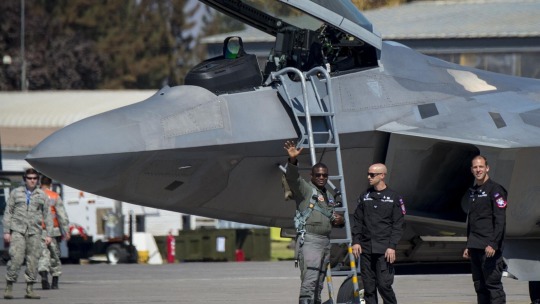
The F-22, which was designed as an air superiority fighter, made its maiden flight in 1997, and eight years later, one of the world’s most expensive warplanes entered service with the US Air Force (USAF).
Last week’s shoot-down of a Chinese balloon by a US F-22 Raptor fighter jet marked the first time the fifth-generation aircraft had downed an airborne target since it made its combat debut in Syria and Iraq in 2015, where the plane carried out strikes on ground targets, Washington-based national security analyst Rebecca Grant told a US media outlet.
Grant pointed out that downing the balloon “was indeed the F-22’s first air-to-air kill.” This was echoed by another news outlet, which reported that the Chinese balloon incident “may be the highest altitude air-to-air kill ever” to have been conducted by a Raptor. So what is this beast all about and why is it considered the most powerful fighter jet in the world? Is it accurate to refer to the F-22 as the best fighter jet in the world? Sputnik has the answers to these and other questions.
What is the F-22? A critical component of the USAF’s Global Strike Task Force, the fifth-generation F-22 was made by Lockheed Martin and designed as an air superiority fighter jet to destroy threats to the US Air Force, Army, Navy, and Marine Corps.
This stealth and all-weather, two-engine warplane featuring integrated avionics and maneuverability first flew in 1997 and entered service with the USAF in December 2005.

A US Air Force F-22 Raptor from Joint Base Elmendorf-Richardson and an F-16 Fighting Falcon from Eielson Air Force Base fly in formation over the Joint Pacific Alaska Range Complex, July 18, 2019 © Photo: Staff Sgt. James Richardson
How Fast is the Raptor? The F-22 is capable of making a so-called “supercruise,” something that helps the jet reach supersonic speeds without afterburning. The aircraft’s maximum speed stands at about 2,414 km/h (1,499 miles/h).
Which Countries Use the F-22? There is only one country that operates the Raptor - the US. The F-22 cannot be exported under a US federal law to secure and protect the warplane’s stealth technology and classified features.
How Many F-22s Does the US Have? Since entering service in 2005, 195 Raptors have been built and currently, eight of them are in testing while the other 187 are fully operational with the USAF.
How Expensive is the Raptor? The F-22's price tag ranges between $206 million and $216 million for just one jet.
Is the F-22 Most Powerful Fighter in the World? Even though the Raptor is touted as the world’s most powerful fighter, the Russian-made Su-35 multirole warplane apparently prevails over the F-22 in terms of maximum speed and range. Unlike the US aircraft's 2,414 km/h, the Su-35’s maximum speed is 2,778 km/h (1,726 miles/h) and its range stands at 3,100 km (1,940 miles). The F-22's range is 2,960 km (1,840 miles).

A F 22 Raptor fighter jet takes part in the NATO Air Shielding exercise near the air base in Lask, central Poland on October 12, 2022 © AFP 2023/Radoslaw Jozwiak
Last year, a US media outlet gave kudos to the Russian warplane, stressing that “although developed primarily as an air superiority fighter, the Su-35 remains a truly multirole aircraft and, unlike its American rival the F-22 Raptor or its Soviet predecessor the Su-27, is capable of deploying a wide range of standoff precision guided weapons for air to ground and anti-hipping roles.”
What Was the Raptor's Combat Debut? The F-22 made its combat debut in 2015, nine years after it was deemed warfare-ready. At the time, the stealth fighter was used primarily to carry out guided airstrikes against Daesh* positions in Syria and Iraq.
The USAF touted the Raptor’s “Success” in those missions as vindication of the warplane that had repeatedly been slammed for being too expensive to operate and an array of F-22-related technical troubles in the mid-2000s, which even led to the grounding of the warplane’s fleet in 2011.
Why Did the USAF Scrap the F-22 Procurement Program? In the 2000s, the USAF's procurement goal of buying more F-22s was questioned over rising costs, initial reliability and availability problems, as well as a lack of relevant adversaries for air combat missions. In 2006, then-US Comptroller General David Walker found that "the DoD has not demonstrated the need" for more investment in the F-22, with further opposition expressed by the Bush administration. Two years later, then-Defense Secretary Robert Gates stated that the F-22 lacked relevance in asymmetric post-Cold War conflicts, and in 2009, he called for production to end in FY 2011 after completing 187 F-22s.

US F-22 Scrapes Ground When Landing…Again! The incident is the latest in a series of similar failures that the F-22, touted by some as “the most lethal combat plane in the world”, has suffered in the past several years. A fifth-generation US F-22 Raptor fighter jet has made an emergency landing, with its nose down on the runway of Eglin Air Force Base in Florida.
In 2016, the House Armed Services Committee cited advances in the air warfare systems of Russia and China and directed the USAF to conduct a cost study and assessment so as to resume production of the F-22s. A year later, the USAF, however, submitted their report to Congress stating they had no plans to restart the F-22 production line due to economic and logistical challenges. The USAF estimated that it would cost approximately $50 billion to procure 194 additional F-22s at a cost of about $216 Million per a jet.
Why Was the F-22 Used to Down the Chinese Balloon?
After an F-22 fired its $400,000 AIM 9X Sidewinder Missile to Destroy a Chinese Weather Balloon over Montana last Saturday, some Questioned the need for using such an expensive jet to bring down a “Harmless” High-Altitude Floating Object.
Supporters of the mission argued that among the fighters the US possesses, the F-22 has the highest service ceiling (about 19 km) and is the most capable of conducting a precision strike at such heights. According to the US Department of Defense, the F-22 launched the missile at the balloon from an altitude of 58,000 feet (around 17km), while the balloon at the time was between 60,000 feet (approximately 18 km) and 65,000 feet (roughly 19 km).
Former Department of Defense analyst-turned anti-war whistleblower and activist Karen Kwiatkowski, for her part, told Sputnik that in any case, the shoot-down of the balloon with the help of a Fifth-Generation Jet looks “Silly.”
Although the US claims that the unmanned balloon was being used for ‘Espionage Purposes’, China insists the airship was a civilian craft engaged in scientific research that was blown off course by high winds.
— Monday February 07, 2023 | By Oleg Burunov
0 notes
Photo

Another view of the abandoned Asylum before it was renovated into a hotel. Richardson Olmsted Complex Former Asylum now “Hotel Henry” Buffalo, New York.
#abandoned buffalo#hotel henry#h h richardson complex#buffalo new york#buffalo graffiti#buffalo#buffalo insane asylum#buffalo asylum#insane asylum#abandonedbuilding#abandoned hospital#abandonment#abandoned asylum#urban ruins#urban exploration#urbex#urbex nyc#urbexworld#urbex world#urbex buffalo#bnicks photography#bnicksss
253 notes
·
View notes
Photo

This is the public-facing rhetorical move par excellence of the radical academic theorist: revel in your radicalism in the seminar room and peer-reviewed journals, but describe your program in the most bland, banal, who-could-possibly-object way for general audiences. Did you know that Marxism is “a refusal to take things for granted”? Why not “follow your dreams” while we’re at it? Never mind the part where “[w]e shall put you in front of a good wall and shoot you,” to quote a poem of Brecht’s. You see this today, too, with the left-identitarians, thinkers who have a nihilistically extensive critique of liberal society—who posit in fact the urgent need to destroy this society—and then, when queried by the public or its representatives, will reply that it’s just about treating people fairly, dude.
But to give the formulation its due, if you truly take nothing for granted, if you never silence the critical intellect, you will in your own mind delegitimize your state and every state, the lives of your neighbors and then your very own life, and you will shoot yourself in the head, as in the aforementioned fictional case of Leo Naphta and the nonfictional one of Mitchell Heisman, possibly after you’ve shot some others à la Brecht or Naptha’s model Lukács, because the critical intellect left to its own devices will annul first the world and then itself. Which is why the profoundest thinkers, i.e., novelists and poets and playwrights, have always suggested a plunge into contact with reality to arrest deconstructive thought processes, from Hamlet to Herzog. Make art, make crafts, have sex, have a child, take a walk, take a drink, dig a garden, plant a tree, get revenge, get a cat—anything at all to remind you that the critical intellect allows itself to be annihilatingly disappointed at the world’s corruption only because it has lost touch with it, literally, and that criticism’s proper service to humanity is as guide and guardrail to action, not as universal solvent.
(Note the details of Hamlet’s example: he only had to kill one person, but deconstructive thought processes made him responsible in whole or part for at least four other deaths and made him suicidal as well; only when he resolved to “let be” could he strike his sole legitimate target, but by then the collateral damage was so great that he forfeited his own life and his country was conquered. A parable for the would-be revolutionary.)
Deconstruction at its best reminded us of these truths, as implied by the quotation from Montaigne that introduces Derrida’s epochal essay on “Structure, Sign, and Play,” but because it was premised on the very purity it set out to debunk—the centered structure organized by neat binary oppositions—it became a very purist argument for impurity. There’s always another binary to undermine over the horizon, always something else and more you could be doing to decenter; so deconstruction finally lent itself to the deranged purity spirals that have marred intellectual life recently. What deconstruction says about strong texts’ essential non-essentialism is basically right, but strong texts achieve this irreducible complexity on tides of emotion that criticism of all sorts has always been bad at capturing, making them elements of reality as well as interpretations of it.
I append all of the above to Leo Robson’s excellent essay-obituary for J. Hillis Miller, from which I draw the opening quotation. This witty catalogue is my favorite paragraph in the piece:
You might say that the effect of deconstruction, in its literary-critical mode, was to augment a presiding canon of largely B-writers (Baudelaire, Benjamin, Borges, Blanchot, etc) with a group of H-figures (Hölderlin, Hegel, Heidegger, Hopkins, to some degree Hawthorne and Hardy), and to replace a set of keywords beginning ‘s’ – structure, sign, signifier, signified, semiotics, the Symbolic, syntagm, Saussure – with a vocabulary based around the letter ‘d’: decentring, displacement, dislocation, discontinuity, dedoublement, dissemination, difference and deferral (Derrida’s coinage ‘différance’ being intended to encompass both). And there was also a growing role for ‘r’: Rousseau, rhetoric, Romanticism (one of de Man’s books was The Rhetoric of Romanticism), Rilke, and above all reading, a word that appeared, as noun and participle, in titles of books by de Man, Hartman, and most prominently Miller: The Ethics of Reading, Reading Narrative, Reading for Our Time, Reading Conrad.
Also this fun fact: “as late as 2012, [Miller] had never read anything by Samuel Richardson.” I am always fascinated by the gaps in brilliant scholars’ reading, and the more time I spent in academe the more I noticed how large the gaps really were. A generalist-dilettante, I try to read a little bit of everything and am consequently bad at being a completist of any one subject or author that a scholar necessarily is. I’ve read Pamela but not Clarissa; for that matter, I’ve read around in Derrida and De Man but, except for his rather psychedelic 2002 primer On Literature, not so much in the late and lamented J. Hillis Miller.
Further reading: my short story, “White Girl,” a dramatization of deconstructive thought processes in action, partially inspired by what I was seeing right here on Tumblr a little less than a decade ago.
14 notes
·
View notes
Text
CMP Travel Program and Section of Invertebrate Paleontology Promotes the 125th Anniversary of the Carnegie Library of Pittsburgh with an outdoor walking tour
Before Carnegie Museums of Pittsburgh (CMP) reopened to the public on June 28th, Barbara Tucker, Director of CMP’s Travel Program, talked with me about ways to reengage members and bring them back to the Oakland museums.
With knowledge about my research on the 125th Anniversary of the founding of the Carnegie Library, Barbara suggested a 90-minute outdoor walking tour around the exterior of the massive building. Starting from where the oldest portion of the building (Portal Entry) meets the newest (Museum of Art) to the front of the historic library entrance, past the Diplodocus carnegii statue, to Forbes Avenue and the entrances of the music hall, natural history museum, and fine arts museum guarded by the statues of the noble quartet.

Fig. 1
The tour was advertised on the CMP website under the Travel Program link, https://carnegiemuseums.org/things-to-do/travel-with-us/ and https://carnegiemuseums.org/kollar/, and accurately described as an activity fully compliant with CDC protocols. Within a week, the tour received overwhelming signups, which were organized by date and number of participants by Travel Program assistant Isabel Romanowski. Three tour dates were set in August and several more in September. Special private tours for donors and others in the fall continue to be arranged.
Andrew Carnegie, Founder:
As guide for an exercise that involves close observation of architectural details, I face the challenge of getting participants to imagine this section of Pittsburgh long before any of the structures around in Oakland existed. The library and museums cover five acres of flat bottom land formed by the pre-Ice Age Monongahela River more than 1.2 million years ago. In far more recent times, the land was part of the Mary Schenley Mount Airy tract of 300 acres which was donated to the City of Pittsburgh in 1889 to create Schenley Park in her honor. Andrew Carnegie, (1835 – 1919) industrialist, steel magnate, and philanthropist, in 1895 saw the site as a place to build a complex with a library, fine arts gallery, science museum, and music hall that would represent the noble quartet of literature, art, science, and music.
The Library Tour Themes:

Fig. 2
Tour groups assemble on the dark stone steps outside the Carnegie Museum of Art (CMOA) rear entrance for an introduction focusing on the two connected, but architecturally different buildings: the Beaux-Arts style Carnegie Complex, with the original structure dating to1895, and later addition to 1907, which was built by Longfellow, Alden, and Harlow using Carnegie Steel (Fig. 2), and the modern Carnegie Museum of Art, built by architect Edward Larrabee Barnes in 1974.
Two rock types distinguish the building exteriors. The older portions of the building are clad in a light grey, easily carved, 370 million-year-old Berea Sandstone from Amherst, Ohio, while the exterior and much of the interior of Museum of Art is covered in the 295 million-year-old bluish iridescence Larvikite igneous rock from Larvik, Norway. When Barnes was commissioned to build CMOA, he chose the dark rock to blend with the older building’s coal dust veneer, a grime coating that was removed when the exterior stone was cleaned in 1990.
Landscape Art and Geology:

Fig. 3
Pittsburgh’s landscape painter, John Kane’s (1860 – 1934), Cathedral of Learning, circa 1930 (Fig. 3), depicts the 150-foot-deep Junction Hollow with its operating railroad. The work also includes many important architectural references, the Schenley Park Bridge (1897), Carnegie Institute’s Bellefield Boiler Plant (designed by Alden and Harlow in 1907 to supply electricity and heat to adjacent buildings), the Carnegie Institute Extension (1907), and a then unfinished Cathedral of Learning. This painting is part of CMOA Fine Arts collections.
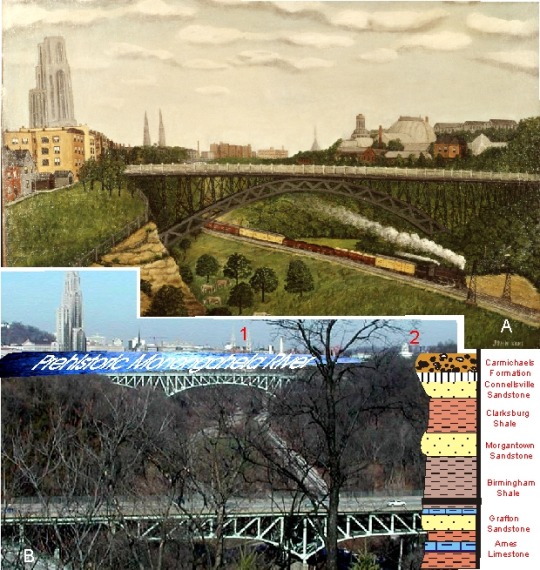
Fig. 4
Another John Kane landscape, Panther Hollow, circa 1930 – 1934, (Fig. 4A) in combination with Cathedral of Learning has been used in teaching about the 300 million-year-old geology of Schenley Park (Fig. 4B2) and the pre-Pleistocene Monongahela River that formed the flat bottom landscape of Oakland, and through erosion, Junction Hollow (Fig. 4B1). Kollar and Brezinski 2010, Geology, Landscape, and John Kane’s Landscape Paintings.
Junction Hollow Landscape:
Kane’s Cathedral of Learning (1930) is an idealized green space of Junction Hollow, the Wilmot Street Bridge in the foreground (1907) now replaced with the Charles Anderson Bridge (1940), and Carnegie Tech’s (now Carnegie Mellon University’s) Hamerschlag Hall or Machinery Hall (1912), built by Henry Hornbostel, a Pittsburgh architect. Hornbostel designed a circular Roman temple wrapped about a tall yellow brick smokestack (Fig. 4A). The design is based on the Roman temple of Vesta in Tivoli, Italy, dating to the early 1st century BC. Hornbostel’s overall campus design focused on connection between art and science, with Junction Hollow representing the geological sciences. The architect Philip Johnston, who built Pittsburgh’s postmodern PPG Place (circa 1984), once contrasted the Bellefield Boiler Plant smokestack as “the ugliest in the world to Machinery Hall’s smokestack as the most beautiful.” In novelist Michael Chabon’s debut novel, The Mysteries of Pittsburgh, (1988) the Bellefield Boiler Plant, termed “the cloud factory” by the narrator, is the setting for a pivotal scene.
Carnegie Library of Pittsburgh (Main):
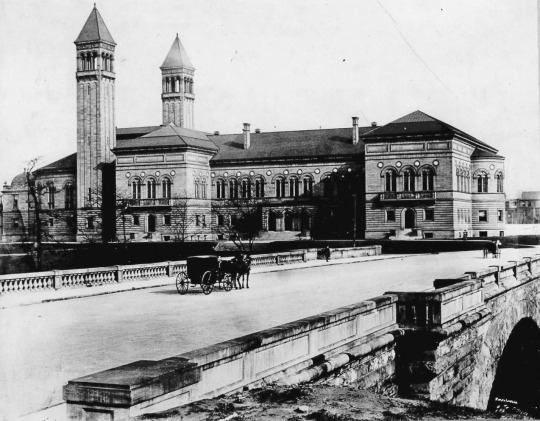
Fig. 5
The separate institutions we now know as Carnegie Museum of Natural History and Carnegie Museum of Art can track their origins to exhibits and galleries within space now fully occupied by Carnegie Library of Pittsburgh. An image of the Carnegie Library of Pittsburgh in 1902 from the Bellefield Bridge, a structure now buried under the Mary Schenley Memorial Fountain (1918), reveals eclecticism in architectural features (Fig. 5). The west facing frontage doorways and portico of the library features, CARNEGIE LIBRARY, FREE TO THE PEOPLE, and 24 carved writer names. Missing from the names is Carnegie’s favorite poet, Robert Burns, whose statue was dedicated in 1914 on the grounds of Phipps Conservancy. Three separate entrances are served by granite steps of Permian age from Vermont, one for the science museum, one for the Department of Fine Arts, and the third, with distinctive Romanesque round doorways, brass doors with intricate features, and keystone scrolling, for the Library. This entrance was designed by Harlow, who was the draftsman on the McKim, Mead, and White team responsible for the Beaux-Arts Boston Public Library (1895). When the Carnegie Institute Extension was constructed in 1907, the science museum and fine arts museum collections were moved into the new space. The former spaces in the library became the Children’s Room, Pennsylvania Room, and Music Library.

Fig. 6

Fig. 7
A challenge at this point in the tour involves discussing features that are not visible up close. The Longfellow, Alden, and Harlow’s Italian Renaissance and Beaux-Arts H-shaped parallelogram winning design featured a copula (Fig. 6) on top of the red tile roof that was never built. Eclecticism features include a double apse, a smaller shaped semi-circular extension of the library’s wall on the southside of the building, and larger apse on the north or Forbes Avenue side of the building, with the semicircular Music Hall auditorium, designed by Longfellow. The music hall exterior was structurally changed by the 1907 construction (Fig. 7).
The exterior Berea Sandstone reveals rustication masonry techniques with the cut blocks on the exterior first floor level distinguished by ashlar pillow horizontal border stone, and smooth masonry from the second floor to the cornice below the roof line. The second floor late Gothic style windows are divided by a vertical element called a mullion that helps with rigid support of the window arch and divides the window panels. Two symmetrical Campanile towers that Carnegie called “those donkey ears” were modeled after the San Marco Bell Tower in Venice, Italy. The towers served as an architectural offset to the semicircular exterior walls of the music auditorium and were removed in 1902 for the construction of the Carnegie Institute Extension. The installation of the towers can be interpreted as a tribute to Henry Hobson Richardson’s Allegheny County Courthouse twin towers (1888).
Architects choice of light grey sandstone and red tile roof:
The library’s red tile roof incorporated multiple glass roofs over the library, fine arts galleries, and science museum (all shaded from exterior sunlight today) which typified the Beau-Arts style. Keep in mind, the library did not have electric light. Light was provided by gas lighting and natural sunlight. Longfellow, Alden, and Harlow wrote that “the choice of a red tile roof and grey Ohio (Berea) Sandstone was intentional to contrast with Pittsburgh’s grey skies and the changing seasonal colors of the foliage in Schenley Park.”
The Beaux-Arts Architecture of the Carnegie Institute Extension 1907:
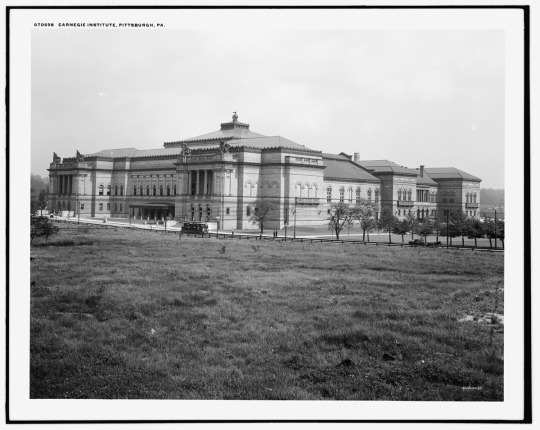
Fig. 8

Fig. 9
After Longfellow returned to his Boston practice in 1896, Alden and Harlow received the commission to build the Carnegie Institute Extension (1907) (Fig. 8). Their efforts created one of the great Beaux-Arts building in the United States. As Cynthia Field, Smithsonian Architecture Historian, stated in 1985, “the building itself is the greatest object of the entire museum collection.” Formal recognition of the building’s architectural importance exists in two historic landmark plagues placed outside of the Carnegie Library entrance and the Museums’ Carriage Drive entrance (Fig. 9).
New exterior features of the 1907 extension work included the replacement of the red tile roof with copper, the addition of an armillary sphere, the construction, with a colonnade of solid Corinthian fluted columns of Berea Sandstone, four portico porches over the main entrances to the library, music hall, natural history and art museum, and eastside of building (now removed), and the creation, along Forbes Avenue, of a main Carriage Drive entrance with direct access to the galleries. The carved names of authors, artists, musicians, and scientists in the buildings’ entablature, a Victorian era practice, extends around the building from the library’s southeast corner to the music hall entrance, and natural history and the fine arts entrances.
Also notable along Forbes Avenue are John Massey Rhind’s noble quartet statues that guard the Music Hall and Natural History and Art entrances. The four male figures all seated in classic Greek chairs are Michelangelo (art), Shakespeare (literature), Bach (music), and Galileo (science). Standing three stories above the quartet on the edge of the roof, four groups of female allegorical figures represent literature, music, art, and science as well. The bronze figures were casted in Naples, Italy in 1907 (Fig 8).
Inside the 1907 Architecture and Building Stones:
The architects created 13 new interior spaces where three grand spaces stand out for specific architecture styles such as, the Beaux-Arts Grand Staircase (voted in 2018 as the 8th best museum staircase in the world), the Neoclassical Hall of Sculpture, and neo-Baroque Music Hall Foyer. The extension used 32 varieties of marbles and fossil limestones, many from antiquity, quarried and imported from Algeria, Croatia, France, Greece, Ireland, Italy, and the United States.
Since 2004, the collaboration between the CMP Travel Program and the Section of Invertebrate Paleontology has been highly successful reaching out to our members and patrons. This summer’s tours generated some particularly appreciative comments:
The Carnegie's resident scientists are a defining characteristic of this noble institution. Might be an anachronism in an era when museums are focused on providing 'destination' entertainment and hosting special events for swells, but while treasures like Dr. Kollar are still on staff, it’s a splendid idea to facilitate interaction between them and museum visitors. Congratulations on a most enjoyable program. -Ron Sommer
Albert was very informative and interesting. I found it most valuable learning the history of the area. -Janet Seifert
I can't stress enough how unusual and interesting it was to have a geologist give us the tour. It had never occurred to me before that there's so much one can learn about building materials from a geologist. -Neepa Majumdar
Albert D. Kollar is Collection Manager and Carnegie’s Historian of the Carnegie’s Building Stones. Barbara Tucker is Director of Carnegie Travel Program.
14 notes
·
View notes
Text
Most important Boybands in history for me
Boy bands have been an important part of pop culture for several decades, each generation has had its Boyband, these vocal groups formed by teenage boys, who sing and dance (there are exceptions), wear matching clothes and drive the girls crazy.
That's why I present some of the most important Boybands in history (some of my favorites and others that even though I'm not a fan I know several songs):
The jackson 5: Considered by many the first Boyband in history, this band formed by the African-American brothers from Gary,Indiana: Jackie, Tito, Jermaine, Marlon and Michael (from oldest to youngest) started in the mid 60s, driven by their father Joseph Jackson, playing in small bars and events in their town, until they were discovered by Motown Records where they began a successful career with Berry Gordy (owner of Motown) and Diana Ross, reaching the top of the U.S. charts with singles like "I Want You Back", "ABC", "The Love You Save" and "I'll Be There", without a doubt they were one of the most influential groups of the time, years later when they went to Epic Records they changed their name to "The Jacksons".
Well, last but not least, in the late 70's Michael Jackson started his solo career, which would lead him to become the most important artist in history and be known as the King of Pop.
Without a doubt, the Jackson Five are one of my favorites and I think most people know at least one of their songs.
J5 medley: https://youtu.be/-4QWtflqqoU
New Kids on the block: This group formed in 1984 by the brothers Jonathan Knight and Jordan Knight, Joey McIntyre, Donnie Wahlberg and Danny Wood from Boston, were a symbol for the boy bands that later in the 90s would succeed them.
They released their first album in 1986, but they jumped to the fame in 1988 with their album "Hangin' Tough" and even more with the release of "Step by step" in 1990 with which they became number 1 in the United States, but it didn't pass much time until in 1994 with the exit of Jonathan Knight, the group ended up separating.
After years in 2008 they announced that the group reunited, which made new tours and later between 2010 and 2012 with the Backstreet Boy made the NKOTBSB tour where they shared the stage singing the hits of both Boy bands, today they continue making music.
The NKOTBSB tour with 2 or more generations!
The Right Stuff: https://www.youtube.com/watch?v=tbIEwIwYz-c
Backstreet boys: It is the most successful Boyband of all time (we must admit that everyone knows at least a couple of their songs), composed of AJ McLean, Howie Dorough, Brian Littrell, Nick Carter and Kevin Richardson, since 1993 when it was formed and after releasing its first album of the same name in 1996, has been a symbol of pop and one of the groups with more record sales in the history of music.
Regarding their music, they obtained their first success in Europe with "We've Got It Goin' On", and from there their popularity began to grow , until with "Quit Playing Games (With My Heart)" they managed to conquer the United States. By the end of the decade of the 90s they release what was their most successful album "Millenium" which debuted in the position n° 1 of Billboard 200 that includes their most successful song "I want it that way" (we all know it's song), then they continue with their album "Black and Blue", which they promoted by traveling the 5 continents in 100 hours, with which they obtained a Guinness record.
After several agitated years, the band decides to take a rest in 2002, although after 3 years they return with a new sound and new tour, but in 2006 Kevin decides to leave the band, reason why Nick, AJ, Brian and Howie decide to continue them 4 with BSB, after several years and new albums, the project NKOTBSB arises where they unite to the New Kids ON The Block to make a tour, in which they announce the return of Kevin to the quintet. Currently, they are still very active after releasing their album "DNA" , whose world tour was interrupted by the covid-19.
My favorite boyband by far, their way of being, their messages in their songs, their iconic choreographies and the power to deal with difficult situations that have been presented to them make me admire them and love each of their songs.
All I have to give: https://www.youtube.com/watch?v=pj6FCKm8dhM
N´ Sync: Considered in the 90s the rivals of the Backstreet Boys, this band composed by Chris Kirkpatrick, Joey Fatone, Lance Bass, JC Chasez and Justin Timberlake who until today continues with his successful solo career; it was created in 1995 by Lou Pearlman, had great success at the end of the 90s until his separation in 2002.
In addition to their great successes with songs like "Bye bye bye", "I want you back" or "Pop", they had the opportunity to work with important music celebrities like MJ, Aerosmith, Celine Dion, Elthon John among others, there is even a chapter of The Simpsons dedicated to them.
One of the strongest features of N' Sync was the dance and its complex choreography.
For me, Justin was always the most outstanding of the group, that's why he continues to be an important artist to this day.
Bye bye bye: https://www.youtube.com/watch?v=Eo-KmOd3i7s
One Direction: British Boyband was born in 2010 after Harry Styles, Liam Payne, Zayn Malik, Niall Horan and Louis Tomlinson, participated in Factor X, where Simon Cowell joined them and created one of the most successful bands of the decade of 2010, debuted with "What Makes You Beautiful" and since then were a phenomenon, filled stadiums, world tours, etc. In 2013 they released "Midnight Memories", which was the best selling album of that year, which contained songs like "Best Song Ever", "Story of My Life" which are some of the most heard songs of the band.
until 2015 when Zayn announced that he was leaving the band, so 1D was left with only 4 members, who in 2016 each began their solo projects, leaving the group on pause until today.
What this band was missing to call my attention, I think was that they didn't dance!
Best Song Ever: https://www.youtube.com/watch?v=o_v9MY_FMcw
BTS: Although this band was formed in 2010 in South Korea and their debut was in 2013 is not until 2017 with the rise of K-pop that have become the most important group of this genre worldwide, formed by Jin, Suga, J-Hope, RM, Jimin, V and Jungkook have remained within the Billboard 200 for a long time with different songs like "DNA" or his EP "Love Yourself: Her", in addition to receiving several awards.
Even Time magazine recognized them as "Next Generation Leaders ", and they were included in the list of the most influential people in the world in 2019.
While this genre of pop is not my favorite, one of my favorite songs is Dynamite at first I was struck by its rhythm, but when I saw the video and all the references to MJ I loved a more.
Dynamite: https://www.youtube.com/watch?v=gdZLi9oWNZg
Michelle Silva H.
3 notes
·
View notes
Text
T H E F E A R S

I mean what I said. These things, these forces, they are our fear. Deep fears. Primordial. Always looking for ways to grow and spread.
I always think it helps to imagine them like colours. The edges bleed together, and you can talk about little differences: “oh, that’s indigo, that’s more lilac”, but they’re both purple. I mean, I guess there are technically infinite colours, but you group them together into a few big ones. A lot of it’s kind of arbitrary. I mean, why are navy blue and sky blue both called blue, when pink’s an entirely different colour from red? Y’know? I don’t know, that’s just how it works.
And like colours, some of these powers, they feed into or balance each other. Some really clash, and you just can’t put them together. I mean, you could see them all as just one thing, I guess, but it would be pretty much meaningless, y’know, like… like trying to describe a… shirt by talking about the concept of colour.
Of course, with these things it’s not a simple spectrum, y’know, it’s more like -
An infinite amorphous blob of terror bleeding out in every direction at once.
Sometimes you impulse buy a kid’s rock painting set from Micheal's of all places and end up using it to make sigils for all of the Fears.
Close ups under the cut (also poetic descriptions drawing from my headcanons about the Fears).
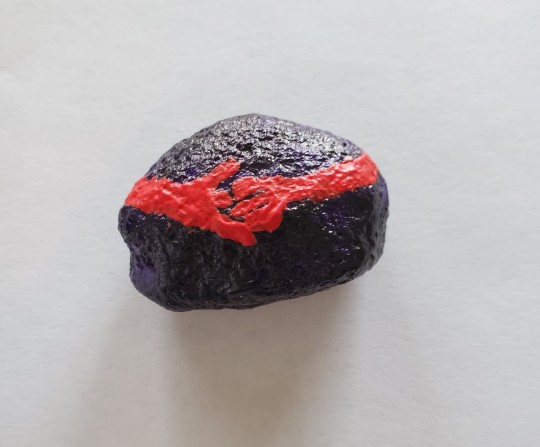
The End. Death. Terminus.
The oldest of all the fears. All other Fears are simply layers separating the fear from it’s source- the fear of death. It was created because of fear, and fear was created because of it. It is the end, the stopping of it all, the force we fight against every day with every breath.
Primary Avatars: The Reapers/Death, The Sybil (Oliver Banks), and The Speaker (”Jane Doe”)
Ritual: It has no need of one, all threads must be cut one day.
Allies: They are all its children.
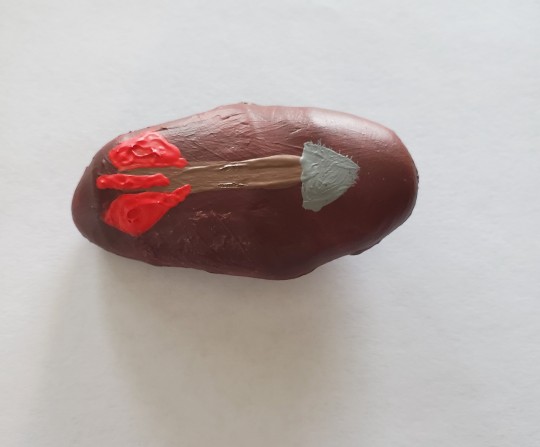
The Hunt.
The End’s firstborn. It was born in the time before sapience, when fear was simpler. But that was still enough. It is a fear for animals, of being hunted down and killed, of being prey.
Primary Avatars: The Hunters and predators [mundane].
Ritual: The Everchase
Allies: The Flesh, The Slaughter, The Desolation, and The Eye.
Enemies: The Vast and The Buried.

The Vast. The Falling Titian.
The child of The End and the twin of The Buried. It began as an animal’s fear, of the fall that shatters your bones of the sea you cannot cross for it is not yours. But with sapience, it evolved. It is falling, heights, lighting, and the Not Yours that surrounds Yours. But also a human’s own insignificance and the true emptiness of the world. It is too much space.
Primary Avatars: The Fairchild family and The Lightning’s (Michael Crew).
Ritual: The Awful Deep
Allies: The Lonely, The Flesh, The Eye, and The Dark.
Enemies: The Buried.

The Buried. The Center. Choke. Too Close I Cannot Breathe
The child of The End and the twin of The Vast. It did not evolve as much as its despised sibling. It is suffocation, and the dirt that fills lungs. But with humans, it became more complex, more existential, as it always does. Those brains can find more in caves than suffocation or the dark. While even an animal fears a small space in case they get trapped and fall to a hunter, only humans could create constructs to bind and crush each other with. It is when there is too little space.
Primary Avatars: The Pit and The Gravedigger (Hezekiah Wakely)
Ritual: The Sunken Sky.
Allies: The Lonely, The Dark and the Web.
Enemies: The Vast, The Flesh, The Eye, and The Slaughter.

The Dark. Mister Pitch. The Forever Blind.
A direct child of The End. The fear of the dark- for it is scary because we cannot know. We cannot see the threats that may hid in its embrace. With the life-giver being a star, it has come to oppose all life and heat. It wishes for blind eyes.
Primary Avatars: The Church of the Divine Host, The Rayner, and the Black Star.
Ritual: The Extinguished Sun.
Allies: The Vast, The Buried, The Stranger, The Spiral, and The Dark.
Enemies: The Eye.

The Desolation. The Lightless Flame. The Devastation. Blackened Earth.
The End’s child. While it sure does love the destruction aspects of fire, it is not just fear of burning. It is the fear of pain and the fear of loss- of power, possessions, or loved ones. It lacks the motivation of The Hunt or the Flesh and destroys more than just lives, unlike The Slaughter.
Primary Avatars: The Church of the Lightless Flame, The Flame’s Messiah (Agnes Montague), and natural disasters [mundane]
Ritual: The Scoured Earth.
Allies: The Slaughter, The Hunt, and the Buried.
Enemies: The Flesh and The Corruption.
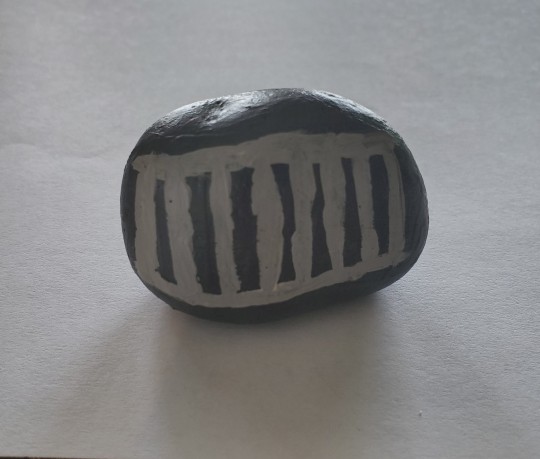
The Lonely. Forsaken. The One Alone.
The End’s youngest solo child and a fear for humans alone. It is the complex webs of society on top of a simple fact- you need the pack to survive. Not to mention that the simple physical brains of humans abhor isolation as well. Isolation, both emotional and physical, strip away one’s mental and physical wellbeing and often driving them to drugs. And simple physical isolation will strip away one’s connection to reality itself, so The Lonely feasts on that unraveling mind just aware enough to fear the fall.
Primary Avatars: The Luckas family.
Ritual: The Forsaken.
Allies: The Buried, The Vast, and The Spiral.
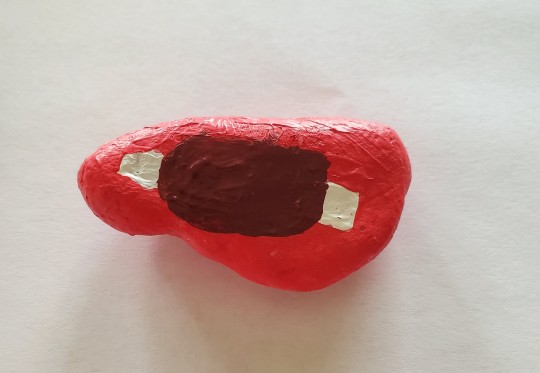
The Flesh. The Meat.
The child of The Hunt and its successor. It is a fear for animals, but those that never know freedom or a game to try to escape. Their path is set, they are the animals raised and slaughtered by humans for meat, with no risk to themselves. They are to be eaten their flesh in a form unconnected to their own appearance, consumed by those who know not how to prepare them. While humans are not raised like that, their separation from The Hunt makes them quiver at the idea of being consumed in any form. With all their knowledge in this era, humans are coming to understand that they may be no different than animals- just organic molecules animated by electricity. The Flesh also feasts on that philosophizing.
Primary Avatars: The Eurachist [mundane] and slaughterhouse workers [mundane].
Ritual: The Last Feast.
Allies: The Hunt, The Corruption, The Desolation, The Stranger, and The Spiral.
Enemies: The Slaughter and The Buried.
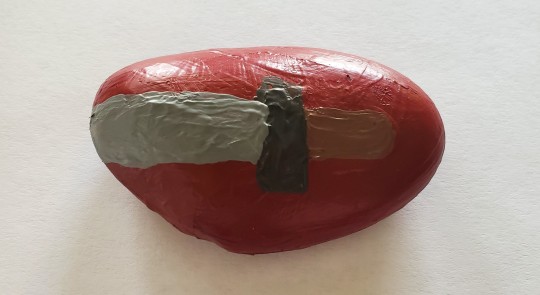
The Slaughter. Violence. War
The child of The Desolation and The Hunter. It the anticipation of uncertain violence. It is violence that isn’t committed for the direct benefit of the murder and/or specifically because of the victim. It is found in both frenzied killers and in the steely, impersonal murder of armies. It rules over all the fear that comes from war, and eats heartily from all the conflicts humans keep creating all by themselves.
Primary Avatars: War Ghosts, The Piper/War, and soldiers [mundane].
Ritual: The Risen War.
Allies: The Desolation, The Hunter, and The Web.
Enemies: The Flesh and the Buried.

The Eye. The Beholding. Ceaseless Watching.
The Hunter’s least favorite child. An animal fears being watched because it means a predator may be observing, but humans have taken that fear as an end onto itself. It is watching, recording, and servailing. It feasts on the scraps of other Fears, reliving the trauma of their victims.
Primary Avatars: The Archive (The Magnus Institute), The Archivist (Jonathan Sims), and The Heart (Elias Bouchard)
Ritual: The Watcher’s Crown
Allies: The Web and The Hunt.
Enemies: The Dark, The Stranger, and The Spiral.
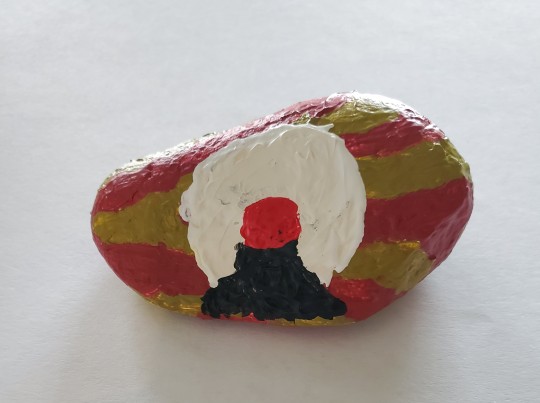
The Stranger. I Do Not Know You.
The child of The Dark, sapience extending the unknown to the other. It is the fear of what is not quite human. But the fear of the humans that are not quite you? Humans spend so much time creating reasons and convincing others to fear eachother. So much mundane fear of the other exists that The Stranger could survive on that alone.
Primary Avatars: The NotThem/dopplegangers, The Circus of the Other, The Deliverers, and bigots [mundane].
Ritual: The Unknowing.
Allies: The Dark and The Spiral.
Enemies: The Eye.

The Spiral. The Twisting Deceit, Esmentiaras, It Is Not What It Is.
The Dark’s other child, for one cannot know if one cannot trust their senses. It is the fear of madness, of unreality. It induces this fear by warping reality, leading its victims to believe they are the ones at fault.
Primary Avatars: The Distortion (once Micheal, now Helen Richardson) and The Worker in Clay (”Gabriel”).
Ritual: Our Great Twisting.
Allies: The Dark, The Stranger, The Web and The Flesh.
Enemies: The Eye.

The Corruption. Filth. Crawling Rot.
The child of The Flesh (but born before The Flesh) and The End. It is a collection of things that are unrelated in reality (bugs, rotten food, poison, mold, decay, and disease), but are associated in the mind of humans lacking knowledge- death without a clear cause and corpses.
Primary Avatars: The Hive (Jane Prentiss) and Pestilence (John Amherst).
Ritual: Unknown.
Allies: The Flesh and The Web.
Enemies: The Desolation.
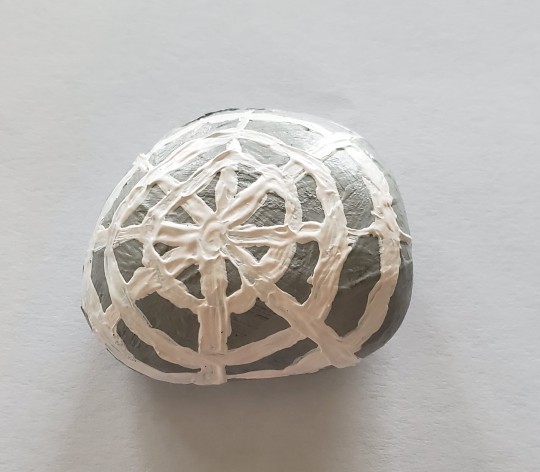
The Web. The Spider. Mother of Puppets.
The child of The Corruption and The Buried. It is the fear of being restrained, but in a more metaphorical sense than The Buried. It is the fear of manipulation, being controlled, and that your will is not your own. And, from its other parent, spiders.
Primary Avatars: The Binding Table, The Spider Horde, and The Patriarch (Raymond Fielding).
Ritual: This world is almost identical to the Web’s, so why bother?
Allies: The Corruption, The Spiral, The Eye, and The Slaughter, The Lonely, The Buried, and The Dark.
Enemies: The Flesh and The Lonely (their relationship is complicated).

The Extinction. The Terrible Change. The Future-Without-Us.
The child of The Stranger and The End, this Fear is still emerging. It developing as humans confront their old hubris about the end times. It is the end of the world, but with no holy rapture. It is an end that isn’t the end of all life, just the end of them. It is the fear of being replaced by another species. It is the fear of how they will ruin themselves. It is the collapse or radical change of society. It is taking all forms of change from the dominions of the other Fears and bringing it into its own.
Primary Avatars: The emergence of true AI [mundane], climate change [mundane], and nuclear weapons [mundane].
Ritual: Many theorize that it seeks to end the world as it is known and replace humans with another sapient species to begin the cycle again.
Allies: The Stranger and The Desolation.
Enemies: Many avatars seek to disrupt its emergence as it would shatter the balance between the powers. They also fear the possibility that The Extinction wouldn’t repopulate the world with a new sapience species right away, setting them back eons.
17 notes
·
View notes
Photo


The Legacy of Sir John Rae
The Rae craton forms a large portion of the Northwest Canadian Shield and is comprised mostly of Archean-aged meta-plutonic rocks commonly overlain by Paleoproterozoic meta-volcanic and meta-sedimentary rocks. The Shield forms the heart of North America, spanning from Baffin Island into the continental US. It is built of several Archean (4 to 2.5 billion years old) cratons (i.e. Slave, Rae, Hearne, Superior) which were amalgamated during Paleoproterozoic (2.5 to 1.6 billion years old) collisional events. These rocks are some of the most extensively reworked continental crust on Earth and have an extremely complex metamorphic history, with some parts of the shield having seen more than eight separate tectonic events.
The Rae Craton is named for Sir John Rae (1813 – 1893), one of the first Europeans to explore the area nearly 200 years ago. Rae was born in Orkney (Scotland) and later attended medical school in Edinburgh. In 1833, he travelled to Canada aboard a Hudson’s Bay Company (HBC) ship to Moose Factory, a small outpost on the shores of Hudson’s Bay (Ontario, Canada) where he resided for 10 years. His first chance to lead an arctic expedition came in 1844 when he was selected by Sir George Simpson to survey unexplored areas of the Canadian Arctic coastline for HBC. The harsh landscape and weather made survival in the arctic challenging, and Rae stood out for his eagerness to learn traditional methods of survival from the local Inuit populations, going against the accepted code of conduct for European explorers of the time.
Between 1846 and 1854 Rae made four more Arctic expeditions to what is now Nunavut, travelling more than 10,000 miles on foot or in a small boat, and surveying a staggering 1,800 miles of previously uncharted arctic coastline. Rae and his crew surveyed many previously uncharted areas of the Arctic coast including Committee Bay, Simpson Peninsula, Melville Peninsula, and Pelly Bay. Rae’s most famous discovery came in 1854, when he realized King William Land was not a peninsula but an Island, discovering the Rae Strait and the last link in the famed Northwest Passage.
Controversy surrounding Rae began in 1848, when it became clear that the infamous Northwest Passage expedition lead by Sir John Franklin would not return. In their search for the missing crew, Rae and Sir John Richardson made several overland expeditions. They found little evidence of Franklins crew; only a few pieces of lumber and several artifacts in the possession of the local Inuit. It was the Inuit who told Rae that Franklin’s desperate crew had resorted to cannibalism. The inclusion of this in his 1854 reports lead to his defamation and discreditation, lead by Lady Jane Franklin and Charles Dickens to preserve Franklins name. Later surveys, including that in 2014 which located Franklin’s ship the Erebus, confirmed Rae’s findings.
Rae is regarded as one of the greatest arctic explorers of all time; a testament to both the great lengths of coastline he mapped and his respect for Inuit knowledge and traditions.
CD
References https://bit.ly/2x5QbI1 https://bit.ly/31wtzhz https://bit.ly/2KRwM5C https://bit.ly/2MPvLgO https://arcticreturn.com/john-rae/
Photos D. Melanson (Melville Penninsula). Used with permission. https://bit.ly/2MQr4DG
#Canada#rae craton#craton#geology#science#expedition#northwest passage#history#shield#arctic#the earth story#nunavut#Hudson bay
44 notes
·
View notes
Text
Knee Jerk Finale Reaction (and a suspicion I've been harboring for a few weeks now)
So I'm still processing a lot of feels over TWW finale. (also: don't let this post fool you, I did enjoy so much of this season)
But I just wanna say that at first final blush, this is entire season ran like a first-time fic writer who has just fucking learned the concept of character arc and decides to use it on everyone at once without any understanding of pacing or any attempt to keep characters to canon.
There was a post a while back that basically said "just because it makes you think or gives you something you don't like/agree with, doesn't mean it's bad writing."
True. So true.
But this was bad writing. Obvious contradictions between previously established canon. Heavy-handed character developments. Problematic themes and characterizations (and here's the thing, I fucking watch Game of Thrones and Sons of Anarchy--problematic characters and situations abound in those shows, but they fucking MAKE SENSE, ffs, and they're not presented on a children's show). And perhaps the greatest crime of simply using a character who has been so lovingly and diligently created by a consummate actress as a mere plot device.
Because that is what Hecate Hardbroom is on this show. A plot device. A machine to move story forward.
Should we be surprised that she was placed in a twisted dilemma with zero real discussion about the trauma that put her there? No. The writers didn't want to explore HB's psyche. She just had to have a horrific secret, so that Mildred would grapple with keeping it. She had to be horrible to Indigo, to make the angry Fake Indie be more believable, until Mildred could save the day with a big reveal. She had to be atrocious towards Julie, to make Mildred steal the wishing star. She had to be adoring of Ethel, to make her lash out at the loss of said adoration in the end. She had to be brutally outed, publicly and painfully, to make Indie run away.
She isn't a character to these writers. She is a tool. Look back at season two--even becoming Miss Softbroom isn't so that HECATE can grow/learn/etc, it's so SYBIL ET AL can.
And yet Raquel Cassidy still came in to work every got damb day and made this plot point human again. She pushed and she shoved her way through that dialogue and fucking made it work. She kept returning to this character with compassion and joy.
Here's the thing: yes, I get that this is a kids show. It absolutely makes sense that Hecate is not the main character, or even *a* main character. But these stories could have been told with relatively little change to their overall structure and still not turned into emotional torture porn--they could have involved students only, and could have been just as emotionally impactful without raising a whole helluva lot of unanswered questions about unresolved childhood trauma, psychological abuse, and even a nice dash of victim blaming. (because let's be real here: Gwen basically tells Hecate "you enjoy punishing yourself" but at some point, an adult in her life--parents, Alma, etc--made her believe that she was deserving of her punishment...I stand by the whole Hecate-sees-life-as-a-meritocracy view and she had to learn it from somewhere)
There was so much to adore about this season. So many sweet, soft moments. But the writers took a character, made her "complex" merely for the sake of other characters' development, and then tossed her out to sea with zero intention of revisiting the trauma they created for her. And for no other reason than they simply could. It's almost like a weird fucking reverse deus ex machina.
Kudos all around to excellent work by Clare, Raquel, and also Jenny Richardson. And I do hope we continue the seemingly yearly tradition of turning over the writers room so perhaps they can come up with a storyline that doesn't negate the idea of personal agency while simultaneously ruining characters just because they can't think of a better/less problematic plot point for a fucking children's show.
Also random side note: I really hope Raquel went to see a chiropractor or at least an amazing masseuse after filming the wedding scene bc homegirl stayed physically tensed at uncomfortably awkward angles throughout. She's so fucking extra, it's wonderful. Like that weird backwards lean in her usual heels....ya girl's quads were S L A U G H T E R E D. What a dork, what a gem, what a dynamite gal. (I'm genuinely serious in hoping she saw someone after that. You really didn't have to go that hard, Raquel, you really, really didn't.)
#tww2017#season three spoilers#finale spoilers#spoilers#for real though i didn't even touch on how this fucked over ada and gwen's characterization#ugh#hecate hardbroom#yo can we stop#please?#otp: hecate and therapy#so much therapy#so much
35 notes
·
View notes
Text
Interesting Papers for Week 23, 2021
High-fidelity musculoskeletal modeling reveals that motor planning variability contributes to the speed-accuracy tradeoff. Al Borno, M., Vyas, S., Shenoy, K. V, & Delp, S. L. (2020). eLife, 9, e57021.
Value-complexity tradeoff explains mouse navigational learning. Amir, N., Suliman-Lavie, R., Tal, M., Shifman, S., Tishby, N., & Nelken, I. (2020). PLOS Computational Biology, 16(12), e1008497.
A generative spiking neural-network model of goal-directed behaviour and one-step planning. Basanisi, R., Brovelli, A., Cartoni, E., & Baldassarre, G. (2020). PLOS Computational Biology, 16(12), e1007579.
Divergent Strategies for Learning in Males and Females. Chen, C. S., Ebitz, R. B., Bindas, S. R., Redish, A. D., Hayden, B. Y., & Grissom, N. M. (2021). Current Biology, 31(1), 39-50.e4.
Neural diffusivity and pre-emptive epileptic seizure intervention. Fagerholm, E. D., Tangwiriyasakul, C., Friston, K. J., Violante, I. R., Williams, S., Carmichael, D. W., … Richardson, M. P. (2020). PLOS Computational Biology, 16(12), e1008448.
Simple models including energy and spike constraints reproduce complex activity patterns and metabolic disruptions. Fardet, T., & Levina, A. (2020). PLOS Computational Biology, 16(12), e1008503.
Ventro-dorsal Hippocampal Pathway Gates Novelty-Induced Contextual Memory Formation. Fredes, F., Silva, M. A., Koppensteiner, P., Kobayashi, K., Joesch, M., & Shigemoto, R. (2021). Current Biology, 31(1), 25-38.e5.
Orientation processing by synaptic integration across first-order tactile neurons. Hay, E., & Pruszynski, J. A. (2020). PLOS Computational Biology, 16(12), e1008303.
Optimal learning with excitatory and inhibitory synapses. Ingrosso, A. (2020). PLOS Computational Biology, 16(12), e1008536.
Contextual Fear Memory Retrieval Is Vulnerable to Hippocampal Noise. Iwasaki, S., & Ikegaya, Y. (2021). Cerebral Cortex, 31(2), 785–794.
Dynamic Suppression of Average Facial Structure Shapes Neural Tuning in Three Macaque Face Patches. Koyano, K. W., Jones, A. P., McMahon, D. B. T., Waidmann, E. N., Russ, B. E., & Leopold, D. A. (2021). Current Biology, 31(1), 1-12.e5.
Searching through functional space reveals distributed visual, auditory, and semantic coding in the human brain. Kumar, S., Ellis, C. T., O’Connell, T. P., Chun, M. M., & Turk-Browne, N. B. (2020). PLOS Computational Biology, 16(12), e1008457.
The Computational, Pharmacological, and Physiological Determinants of Sensory Learning under Uncertainty. Lawson, R. P., Bisby, J., Nord, C. L., Burgess, N., & Rees, G. (2021). Current Biology, 31(1), 163-172.e4.
A functional theory of bistable perception based on dynamical circular inference. Leptourgos, P., Bouttier, V., Jardri, R., & Denève, S. (2020). PLOS Computational Biology, 16(12), e1008480.
A mathematical model of local and global attention in natural scene viewing. Malem-Shinitski, N., Opper, M., Reich, S., Schwetlick, L., Seelig, S. A., & Engbert, R. (2020). PLOS Computational Biology, 16(12), e1007880.
Common cell type nomenclature for the mammalian brain. Miller, J. A., Gouwens, N. W., Tasic, B., Collman, F., van Velthoven, C. T., Bakken, T. E., … Bernard, A. (2020). eLife, 9, e59928.
Optimal Local Estimates of Visual Motion in a Natural Environment. Sinha, S. R., Bialek, W., & de Ruyter van Steveninck, R. R. (2021). Physical Review Letters, 126(1), 018101.
A Bayesian computational model reveals a failure to adapt interoceptive precision estimates across depression, anxiety, eating, and substance use disorders. Smith, R., Kuplicki, R., Feinstein, J., Forthman, K. L., Stewart, J. L., Paulus, M. P., … Khalsa, S. S. (2020). PLOS Computational Biology, 16(12), e1008484.
Early Emergence of Solid Shape Coding in Natural and Deep Network Vision. Srinath, R., Emonds, A., Wang, Q., Lempel, A. A., Dunn-Weiss, E., Connor, C. E., & Nielsen, K. J. (2021). Current Biology, 31(1), 51-65.e5.
Exact neural mass model for synaptic-based working memory. Taher, H., Torcini, A., & Olmi, S. (2020). PLOS Computational Biology, 16(12), e1008533.
#science#Neuroscience#computational neuroscience#Brain science#research#neurobiology#mirror neurons#cognition#cognitive science#psychophysics#scientific publications
13 notes
·
View notes
Text
Sundance 2022: Day 4

Number of Films: 4
Best Film of the Day: After Yang
892: A non-heist movie. Abi Damaris Corbin’s fact-based film has some of the trappings of the bank-robbery thriller, only, its protagonist, former Marine Brian Brown-Easley (John Boyega) isn’t interested in the bank’s money at all. Instead, when he walks into an Atlanta-area branch of Wells Fargo one morning, claiming he has a bomb, what he’s after is a platform to air his grievances with the VA, the byzantine agency that withheld his benefit check based on a clerical error. At the beginning of the film, we meet Brown-Easley, a decorated veteran with severe PTSD since being honorably discharged, living near the poverty line, and on his way to becoming homeless. Separated from his wife, Cassandra (Olivia Washington), and the couples’ young daughter, Kiah (London Covington), he has little recourse when his disability check is lost in a sea of bureaucracy. Pushed well past the breaking point, he calmly enters the bank, and respectfully informs the pair of bank managers, Estel (Nicole Beharie) and Rosa (Selenis Leyva), he is carrying a bomb in his bag. He encourages them to call “everyone,” including the police, the fire department, and the media, giving him as much opportunity to express himself as possible. From the start, it’s clear he’s a different sort of cat. Unerringly polite (everyone is “sir,” or “ma’am”), and conscientious (at one point, he fields a call from a customer, and writes down their information to give to an appropriate bank employee), he’s also completely aware this action will result in his death at the hands of police, a point he makes more than once to the lead police negotiator (the late Michael K. Williams, in his last role), working hard to diffuse the situation. The film’s air of menace is well-crafted by Corbin and her team, dragging out the tension as Brown-Easley makes his case, both to the police, and to the media, via a phone call to a local news producer (Connie Britton). The end result, while expected, still comes shockingly, leaving a bevy of unanswered questions Corbin rightly has no interest in answering.
After Yang: I hadn’t planned to see Kogonada’s emotional drama set in the near future about an expired robot, but after its premiere, the intense buzz about it became too much to ignore, and I’m very glad I added it to my schedule. Emotional, yet restrained, it’s the kind of film whose very ineffability adds to its considerable power. Set in the near future, where lifelike robot companions are common, we meet Yang (Justin H. Min) very near the end of his use cycle, to the unhappiness of his current family, including Jake (Colin Farrell), owner of a high-end loose tea shop, his wife, Kyra (Jodie Turner-Smith), a marketing executive, and their young adopted daughter, Mika (Malea Emma Tjandrawidjaja), whose Chinese heritage the couple hoped to connect her with through Yang, programmed with Chinese history, in the first place. In an attempt to restore Mika’s beloved companion, Jake takes him to various tech outlets, eventually learning his core has been corrupted beyond repair, but leaving his key memory module intact, enabling Jake and Kyra to view his recorded memories, both of his time with them, and with his former “employers,” including several other families. Joined by Yang’s at-first mysterious friend, Ada (Haley Lu Richardson), the family slowly unwinds the robot’s past life experiences, allowing them, at last, to have a better understanding of their former companion. Kogonada’s style, meticulous and measured, plays wonders with the material, based on the short story by Alexander Weinstein, moving in subtly effective beats instead of rising dramatic tension. Philosophically complex, dense with strikingly beautiful imagery, the film hints at much of the inexorable tragedy of the human condition, constantly losing things, while desperately trying to hold onto what we can via our very fallible memories. The film never asks you to cry, but you likely will, and probably more than once.
Nothing Compares: It’s nowhere near often enough, sadly, but sometimes a much maligned figure, whose views are considered apostatic at the time, lives long enough to see the world finally come around to them. Such is the case for Sinéad O’Connor, the former mega-watt musician and singer, whose direct challenging of both the patriarchal music industry, and Catholic Church made her a pariah, and the subject of countless hit pieces by the media in a futile attempt to shut her up. In the late ‘80s and early ‘90s, after the worldwide success of her first two albums (in particular, the Prince-helmed single “Nothing Compares 2 U,” which became a global number one song), O'Connor, a small-but-hardy woman of uncommon strength and will, used her new found fame as a bully pulpit, calling out systemic racism, condemning hawkish politicians, and, most famously, tearing up a photo of the pope on live TV during a performance on “SNL.” At the time, these acts mostly cost her career (though she still recorded and performed with regularity), but with the benefit of time — and the worldwide scandal that enveloped the Church in the years since her outburst — her decisions, and her fearless outspokenness against hallowed institutions have granted her much in the way of retroactive appreciation. Fellow Belfastian Kathryn Ferguson’s hagiographic film, which she admits, is representative of how she has always viewed the controversial singer, focuses primarily on those years between 1987-1993, when the diminutive singer went from unknown waif to global superstar, and back down again, utilizing a combination of archived footage under VO’s by O’Connor and various friends and associates. With the recent suicide death of her first son, Jake, O’Connor’s life has taken another tragic turn, but nothing takes away from her body of work, and the courage with which she has lived her life.
Alice: In a sort of inverted version of the 2020 film Antebellum, Krystin Ver Linden’s film, based on a true story, follows the life of its heroine, Alice (Keke Palmer), who lives at the plantation of your ubiquitous horrible white slave owner, Paul Bennett (Jonny Lee Miller), suffering along with the other slaves under his brutal hand. When she finally resolves to run away, shortly after seeing her husband, Joseph (Gaius Charles), shot down in cold blood, she runs wildly through the woods only to end up standing next to a superhighway in Georgia. Despite everything she was led to believe by Paul Bennett and his equally horrible wife, Rachel (Alicia Witt), the time period isn’t pre-Civil War, but 1973. Quickly befriending Frank (Common), a kindly truck driver, Alice takes to her new reality rapidly, reading everything she can get her hands on, and learning to appreciate the talents of Pam Grier socking it to Whitey in Koffy. Almost immediately, she plans a raid on the Bennets’ illegal “plantation,” to free the others, and enlists Frank’s aid to help her. You can certainly see what director Ver Linden is going for here, starting with a plantation depiction and morphing it into a “blaxploitation”-era type revenge thriller, but the film suffers from tonal dissonance, and clunky, expository scenes that move Alice too quickly from confused, terrified cultural alien, to assertive, wise-cracking, gun-toting badass, such that everything feels too forced and contrived to hit its marks. Tarantino does a similar sort of trick in Django Unchained, but for all his foibles, he is a brilliant subverter of existing genres, a skill, at this point, the callow Ver Linden does not have on offer. There are good things at play here, not the least of which Palmer’s high-wire performance, but too many wrong notes eventually ruins the symphony.
The Sundance Film Festival has returned, albeit in virtual-only format. We might not be skating on the ice and snow of Park City, but we’re still going to take in a whole bunch of independent films, some of which might be the best things we get to see this year. Let’s see how it goes.
#sweet smell of success#piers marchant#ssos#movies#films#sundance film festival 2022#park city utah#indie#virtual film fest#after yang#892#alice#nothing compares
0 notes
Text
J. Cole Encourages Aspiring Artists To “Come Together”

J. Cole made headlines recently for demonstrating his dedication and heart for hip-hop and the community. Cole not only took the time to lend an ear to an aspiring rapper. But he took a minute to offer valuable advice to others in attendance from his wealth of wisdom.
J. Cole
Cole is a self-taught artist with a depth of talent. He devoted much of his younger years to mastering the arts of lyrical flow and production. And he continued to hone his skills through high school and college. Graduating from college with honors in 2007 would not be his only accomplishment. 2007 would also be the year he set his career in motion.
Meant To Be
His debut project, "The Come Up," would come out the same year as his graduation. However, fate would not take a turn until 2009. Reportedly, Cole's work caught the ear of a music executive named Mike Pitts. And ironically, Mike Pitts had the ear of Jay Z. According to Biography, a young, ambitious Cole had once before attempted to bend Jay-Z's ear but with no success. But this time, things would be different; everything would align and lead to an extraordinary outcome, proving if one believes in a dream, one never gives up the hustle. Jay-Z listened, liked what he heard, and signed Cole. And the rest, as they say, is history.
It's Built In
In the years since Cole has not relented in getting things done. Not only has he released five studio albums, but he's also produced some top-tier talent, which includes Kendrick Lamar. He started a label, Dreamville, and created a similarly named non-profit. He has always been a light in his community and has shown time and time again that he is not a stranger to giving back. As seen in his visit to an NYC apartment complex on March 22, it is just a part of who he is.
Ty Trilly's J. Cole Experience
An aspiring hip-hop artist, Ty Trilly, was more than a little hyped when J. Cole showed up to lend an ear to his work in progress, "Adapt." The artist was so impressed and grateful that he shared the experience on social media. According to Ty Trilly,
"Cole pulled up on me to hear my new shit, No Meetings in the city, straight Raw block shit,"
Trilly didn't stop at that. He continued to expound on his shock at the advice Cole gave him. Cole mclarifiedthat he didn't merely come to listen; he came to share some knowledge. He had every intention of giving the artist the push he needed. Cole pushed Ty Trilly to move forward with what he had. This is what Ty Trilly cited Cole as saying,
"Just that! Shoot the video, put that b***h out, it's gon' land on the people it's supposed to land on."
Those are words that so many can benefit from. Sometimes you have to put it out there.
A Wealth of Wisdom
Cole didn't only train his focus on Trilly. He offered words of wisdom to the collective, encouraging them to unite as one powerful unit. Cole is cited as saying,
"it's already a network over here. You n***as just gotta come together; you know what I mean? There are too many people right here not to have the network."
That is an example of foundational building in action.
Conclusion
Performers/artists may seem monolithic, but most aren't. It often takes many skills to make it to a position of prominence. However, those other skills are often glossed over. Cole entered the industry with the heart of a preserver, an intellectual's mind, and a giver's soul. So giving back was something already built-in him. Therefore, dropping in on an aspiring artist’s creative turf is not odd. This merely reflects who J. Cole is, and is an example that many could aspire to follow.
Written by: Renae Richardson
Read the full article
0 notes
Text
A tale of two surgeries
New Post has been published on https://depression-md.com/a-tale-of-two-surgeries/
A tale of two surgeries

Some advice is best ignored. Like the warning Kyla Ortved received while volunteering in a small animal clinic as a teenager. One of the clinicians told her vet school was too hard to get into. The woman recommended Ortved do something else.
Fortunately for horse owners, students, and veterinary science in general, Ortved paid little attention. Twice board-certified—by the American College of Veterinary Surgeons and the American College of Veterinary Sports Medicine & Rehabilitation—today Ortved is a rising star in equine sports medicine and large animal surgery. And she runs the Ortved Laboratory at the School of Veterinary Medicine’s New Bolton Center, which studies post-traumatic osteoarthritis and explores regenerative medicine therapies to benefit horses and humans.
“I have a very specific memory of when I decided to specialize in surgery,” says Ortved, the Jacques Jenny Endowed Term Chair in Orthopedic Surgery. “During one of my externships, a resident invited me to participate in a procedure. The horse was under anesthesia for a check ligament desmotomy, a surgery to cut the check ligament for club feet. I helped with the surgery and realized: ‘This is it.’ And it still is. When I am doing surgery, I lose track of time. I’m where I’m meant to be.”
Up for a challenge
Recently, this place was with Osada, a two-month-old Friesian with a left tibial fracture.

Osada, a young Friesian, received a kick from another horse and wound up with a left tibial fracture. Kyla Ortved and other veterinarians at New Bolton Center repaired the bone with a surgical approach involving locking plates and screws that is typically used in humans.
“She was kicked by another horse,” says Daniel Lapp, owner of Red Crest Stables and breeders in Gordonville, Pennsylvania. “Our vet came to the farm to check her and asked if we’d want to pursue surgery, although she said it was a long shot.”
Lapp thought a long shot better than no shot, and the referring vet sent Osada’s X-rays to Ortved for an opinion.
“It was a really severe fracture that was complicated by a second fracture at the growth plate at the top of the bone,” says Ortved. “In foals we usually see one or the other but rarely both. I knew it would be a bit more challenging to repair.”
She put Osada’s prognosis at 50%.
“I said go for it,” recalls Lapp.
Going for it
The New Bolton Center surgical team, which included radiology and anesthesia specialists and surgical nurses, prepped the horse. Dean Richardson, the Charles W. Raker Professor of Equine Surgery, also scrubbed in.
Osada was placed under general anesthesia. Two long, locking compression plates were carefully screwed into the bone in two places, a fracture repair approach for humans that Richardson adopted for equines early in his career.
After a lengthy, complex procedure—“the tibia is a hard bone to work with because access is difficult,” explains Ortved—they closed the incision in several layers, covering it with a light bandage.
The filly sailed through the surgery and subsequent recovery, but she wasn’t out of the woods. “The thing we’re most worried about in these cases is the implant becoming infected and the repair staying together,” Ortved says.
To mitigate the risk of infection, Osada received antibiotics, as well as anti-inflammatory medication and morphine for pain.
Over the past several decades, there have been so many advances in nursing care materials, in anesthesia, in surgical approaches that fractures don’t have to mean death. There are more options today.
Kyla Ortved, assistant professor of large animal urgery, School of Veterinary Medicine
A few days post-op, Ortved’s fears came true. The wound opened and fluid leaked from Osada’s leg. The team cleaned the incision and performed a vacuum-assisted closure therapy to encourage drainage and healing. A bacterial culture found infection, so Ortved changed the horse’s antibiotics.
When Osada’s comfort didn’t improve, Ortved took her back to the operating room to lavage the wound. “She had an infection in the joint. We flushed the joint and placed antibiotic-impregnated bone cement in the wound to help with healing.”
The treatment worked. The wound started to close, and Osada slowly improved. She was discharged a few weeks after her last procedure.
21st-century surgery
“In the horse world, many people still think that fractures mean euthanasia,” Ortved says. “One of the takeaways from Osada’s case is that over the past several decades there have been so many advances in nursing care materials, in anesthesia, in surgical approaches that fractures don’t have to mean death. There are more options today.”

Veterinarians Amanda Watkins, Alycia Crandall, and Angela Gaesser were part of Osada’s care team, which included not only surgeons but also radiology and anesthesia specialists and surgical nurses.
Cases like this one and legends like Richardson are among the top reasons Ortved joined New Bolton Center’s clinical team and faculty in 2016. A world-renowned surgeon, Richardson recently received the American College of Veterinary Surgeons ACVS Founders’ Award for Career Achievement for “contributions over the last 30+ years [that] have greatly impacted the art and science of veterinary surgery.”
Ortved says, “Working with Dean is an incredible opportunity and has vastly outweighed my expectation. I am unable to even come close to quantifying what I have learned at New Bolton Center and from him in the last five years.”
Raised on surgery
Ryan Hospital surgical resident Chiara Curcillo has conducted fewer surgeries than Ortved. But she has been around the specialty for many years, in a sense having grown up at Penn Vet.
Curcillo’s physician parents pioneered a single incision, minimally invasive laparoscopic surgical technique for humans. Jeffrey Runge brought it to animals when he was an assistant professor of surgery at Ryan Hospital.
“My parents would help Dr. Runge with the early procedures and take me along for the ride, knowing I wanted to be a veterinarian,” says Curcillo. “Dr. Runge guided me to where I am today. I spent several years shadowing him in the operating room [OR] and on the clinic floor. Having two surgeons raise me and a surgeon as my mentor made me want to be a surgeon and spend my days in the OR just like them.”
Quills, quills, and more quills
Curcillo had one of her trickiest surgeries yet with Daisy, an American Staffordshire Terrier who had an altercation with a porcupine right after Thanksgiving. The run-in resulted in what seemed like an endless number of quills stabbing the dog’s face and traveling throughout her body.

Daisy’s face and body were riddled with quills following her porcupine encounter, some of which compromised internal organs.
“We were visiting rural New York State and took her to an ER immediately, where they removed quills from all over her face and body,” says Katie Leonard, who, along with her husband, Franklin Donn, adopted Daisy in 2019. “As soon as we picked her up, we noticed more quills poking from her chin and pulled them.”
Additional quills surfaced when the couple, along with Daisy and Daisy’s canine brother Dexter, returned home to Baltimore.
But more worrisome symptoms overshadowed the quill appearances. Daisy’s breathing was labored, and she had lost interest in food and water.
At an ER in Baltimore, she was diagnosed with a pneumothorax, a dangerous condition of air in the chest cavity that can cause the lungs to collapse if untreated. Using a minimally invasive procedure called thoracocentesis, the ER vet placed a needle through Daisy’s chest wall into her chest cavity to remove air. Daisy was referred to a specialty practice, the third vet stop at this point.
Fourth and final stop
“Given the complexity of Daisy’s case, this last veterinarian then referred Daisy to us for further imaging and surgery,” Curcillo says.
This was the hope the family needed. “We weren’t feeling confident until we got to Ryan,” says Leonard. “Dr. Curcillo was very clear about the severity of Daisy’s situation but optimistic that all was not yet lost.”
After sedating the canine under general anesthesia and conducting a CT scan, Curcillo and Lillian Aronson, professor of surgery, opened Daisy’s chest and abdominal area. David Holt, professor of surgery, offered a hand.
Inside, the surgeons found a body riddled with quills—they were in the heart, lungs, liver, spleen, pancreas, kidney, diaphragm, and body wall.
“We removed each gingerly,” says Aronson. “We identified penetrating wounds in one of her lung lobes and performed a lung lobectomy. And we leak tested the other lobes, repairing a defect in one.” Before finishing the procedure, they placed a chest tube to help expel air.
Curcillo was working alongside the best: Aronson is a pioneer in small animal surgery and one of the first veterinarians in the world to perform renal transplants in dogs and cats—she’d conducted hundreds long before other surgical practices did any.
Also a noted small animal surgeon, Holt made news recently for charting an innovative approach to cancer surgery that helps surgeons clearly see whether they’ve left any diseased tissue behind in cancer excision surgery.
An ordeal continued
Post-op, Daisy woke up from anesthesia uneventfully and was transferred to the intensive care unit for monitoring. But, as with Osada, another hurdle was soon to come.
Day three after surgery, she developed abdominal discomfort and had fluid in her abdomen, as well as a suspected second pneumothorax.
It was back to surgery. Curcillo and Aronson opened her chest and abdomen again to evaluate the situation. After removing a few migrated quills, they examined her lungs, which had no apparent leaks, and replaced the old tube with a new one.

Curcillo and Lillian Aronson, another of Daisy’s surgeons, pose with their special patient.
But air continued to escape post-surgery. In a minimally invasive procedure, “We then inserted an autologous blood patch to seal the sites in her lungs that were possibly leaking,” says Curcillo.
This did the trick. The rest of Daisy’s hospitalization progressed smoothly, and she was discharged a few days later.
A long and loving journey
“It’s been a long road for this sweet, outgoing dog,” says Curcillo. “But given her young age and that she is otherwise healthy, we believed this was a well-considered journey to take.”
Quills continue to surface even months after Daisy’s face-off with the spiky rodent—her owners estimate well more than 100 quills have been removed in total since November. And she has been back to Penn Vet several times for follow-ups and removal of aberrant spikes.
I don’t know if I’ll ever see another case like this. It was intense, challenging, and pretty cool—a perfect example of the type of surgery I’d hoped to experience at Penn Vet.
Chiara Curcillo, Ryan Veterinary Hospital surgical resident
“Penn Vet is the only place we’ll go for our girl,” says Leonard. “We have wonderful pet insurance, thankfully. And Drs. Curcillo and Aronson and all of the clinicians who have worked so hard for Daisy are our ‘Team Daisy.’ We adore them.”
For Curcillo, Daisy is an unforgettable pup.
“I don’t know if I’ll ever see another case like this,” she says. “It was intense, challenging, and pretty cool—a perfect example of the type of surgery I’d hoped to experience at Penn Vet. Working next to Dr. Aronson and Dr. Holt is amazing—I am frequently in awe of them during a procedure. They teach me to be a great surgeon and a great educator. I aspire to be half the surgeons and teachers they are.”
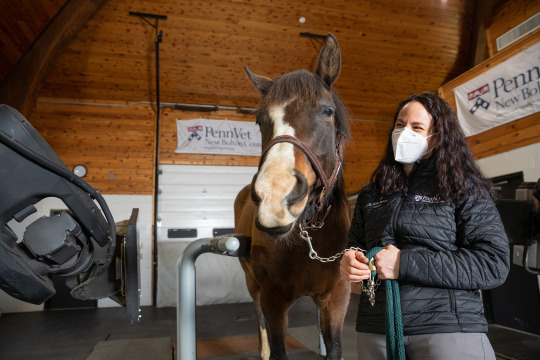
Kyla Ortved runs the Ortved Laboratory at the School of Veterinary Medicine’s New Bolton Center. (Image also featured on Homepage)
Source link
0 notes
Text
Why Clash Of The Titans Was The End Of An Era
https://ift.tt/3xChOFQ
It was 40 years ago, in June 1981, that Clash of the Titans, the last film to feature the stop-motion animation effects of Ray Harryhausen, was released.
Starring a then-unknown Harry Hamlin, along with veteran stars like Laurence Olivier, Maggie Smith, Burgess Meredith, and Ursula Andress, the film was loosely based on the Greek myth of Perseus (Hamlin), weaving in strands of other mythologies and legends and putting its hero into conflict with creatures like the Kraken, Calibos, Medusa the Gorgon and a two-headed dog named Dioskilos.
“Greek and Roman myths contained characters and fantastic creatures that were ideal for cinematic adventures,” wrote Harryhausen in his memoir, Ray Harryhausen: An Animated Life. “If some of the adventures were combined with 20th century storytelling, a timeless narrative could be constructed that would appeal to both young and old.”
Harryhausen was already a filmmaking legend by the time he began work on Clash of the Titans. Born in Los Angeles on June 29, 1920, a 13-year-old Harryhausen’s life was changed when he saw King Kong for the first time in 1933. Inspired by the groundbreaking stop-motion animation work in that film by Willis O’Brien, Harryhausen began experimenting with his own short films employing the same process.
He got to meet O’Brien at one point, with the visual effects pioneer encouraging the young Harryhausen to keep refining and improving his work. Some years later, after attending USC, doing a stint in the military during World War II and working at his first professional job on George Pal’s Puppetoons, Harryhausen landed a job as O’Brien’s assistant on Mighty Joe Young (1949).
It was on 1953’s The Beast from 20,000 Fathoms, the first film on which Harryhausen was in charge of the visual effects, that he created the process known as “Dynamation,” which allowed for greater and more realistic interaction between his stop-motion creatures and live actors.
In 1955, Harryhausen met producer Charles H. Schneer and formed a partnership that would begin with Harryhausen’s next feature, It Came from Beneath the Sea (1955), and last all the way through their final collaboration on Clash of the Titans.
Their run of pictures included fantasy and sci-fi classics such as Earth vs. the Flying Saucers (1956), 20 Million Miles to Earth (1957), The 7th Voyage of Sinbad (1958), Jason and the Argonauts (1963), One Million Years B.C.(1966), The Golden Voyage of Sinbad (1974) and many others.
Unlike many visual effects artists even to this day, Harryhausen had an unusually high degree of creative control over his projects. He didn’t just animate the monsters; he was involved in the conceptual and story development, production design, and many other aspects, acting as a co-producer with Schneer and sometimes as a co-director — an agreement that any director of a Harryhausen film had to abide by.
Harryhausen even received co-producer credit on The Golden Voyage of Sinbad, a title he would also officially obtain on his and Schneer’s next and last two pictures, Sinbad and the Eye of the Tiger (1977) and Clash of the Titans. “I felt he deserved it,” Schneer told Starlog magazine (#152) in March 1990. “It was a recognition that Ray contributed more than just the special FX. His input was added from day one.”
Clash of the Titans was an idea that Harryhausen had been kicking around since the late 1950s, with screenwriter Beverley Cross (who wrote the final script for Titans) penning a treatment called Perseus and the Gorgon’s Head in 1969. Although the plans were delayed by the next two Sinbad pictures, work on the project began in earnest as Sinbad and the Eye of the Tiger neared completion.
“The original legend of Perseus is complex and convoluted,” wrote Harryhausen in An Animated Life. “So we had to manipulate events, stealing from one legend and putting it in another.” Harryhausen cited the creation of the winged horse Pegasus as one example: in the original story, Pegasus is born from the blood of Medusa’s severed head. But since her death would come near the end of the film, a different scene involving Perseus capturing and training Pegasus was conceived to bring him in earlier.
With a screenplay and production storyboards ready, Schneer presented the film to Columbia Pictures, where he and Harryhausen had a number of successes over the years. But the studio balked at the $15 million budget — more than all Harryhausen and Schneer’s previous films combined — so Schneer next brought it to Orion Pictures.
MGM/Warner Bros.
That company had one request: cast a then obscure but up-and-coming bodybuilder-turned-actor named Arnold Schwarzenegger as Perseus. This time Schneer and Harryhausen balked. “I told them he didn’t fit the part, because it had dialogue,” Schneer told Starlog. “But Orion considered his casting to be a deal breaker. They refused to accept another actor, so I walked out on them.” Eventually, Metro-Goldwyn-Mayer showed great enthusiasm for the project, providing the full budget and even a bit more.
Schneer, Harryhausen and director Desmond Davis — whom Schneer had hired because of his work with Shakespearean actors on several BBC productions of the Bard’s plays — looked at Malcolm McDowell, Michael York and Richard Chamberlain for Perseus before choosing Hamlin. “Harry had only made one picture, but had considerable stage experience,” wrote Harryhausen. “Not only was it felt that he would be able to handle the role and the effects, but he also looked the part.”
Hamlin told Starlog (#46) in May 1981 that he was initially reluctant to take the role, thinking it would be strictly a monster picture, until he saw the rest of the cast that was involved. But he was also drawn to the idea of playing a hero in the classical sense.
“I’m playing an across-the-board Greek hero type,” he explained. “Perseus has no superpowers himself. He has a few accoutrements, such as a sword and a helmet which makes him invisible. He has a magic shield. He’s a real hero in the classic sense. It’s a good role. I’ve always wanted to be a hero.”
Esteemed British actors like Olivier, Smith, Jack Gwillim, Claire Bloom and Sian Phillips embodied the constantly scheming, calculating gods Zeus, Thetis, Poseidon, Hera, and Cassiopeia, while Meredith — best known as the Penguin on the Batman TV series — was cast as the playwright Ammon. John Gielgud, Ralph Richardson and even Orson Welles were considered for Zeus until Olivier accepted the role.
“I told Ray that if he thought he was the star of our pictures, then I was going to upstage him once and for all,” Schneer jokingly told Starlog. “I was going to cast actors who were bigger names than he was, and whose work the world knew better than his. I wanted to see if he could survive.”
Read more
Movies
10 Forgotten Giant Monster Movies
By Marc Buxton
Movies
25 great stop-motion moments in live-action films
By Ryan Lambie
The movie begins with an infant Perseus and his mother Danae being sealed in a box and cast into the sea by Danae’s father, King Acrisius, who is enraged that the god Zeus (Olivier) impregnated Danae with the child. Perseus is rescued and grows to become a young man, while a furious Zeus orders from Olympus that the Kraken — last of the Titans — be released to destroy Acrisius and his kingdom.
Sometime later, the adult Perseus wants to win the hand of the beautiful Andromeda (Judi Bowker), who was once betrothed to a prince named Calibos. But Calibos (played by both actor Neil McCarthy and a stop-motion model) was turned into a monster by Zeus after the former offended the gods, and any prospective new husband for Andromeda must now answer a riddle concocted by the man-monster.
Andromeda is eventually offered to the Kraken as a sacrifice even after Perseus successfully answers the riddle. The only way for the giant sea creature to be defeated is for Perseus to voyage to the island of Medusa, sever her head, and use her eyes to turn the Kraken into stone — unless Perseus succumbs first.
Clash was shot at England’s Pinewood Studios, with location filming in Spain, Malta, and southern Italy. Principal photography began in May 1979 and concluded in September of the same year. Harryhausen then began the arduous, 18-month process of creating all the Dynarama effects (Dynamation had been renamed) and animating all the film’s creatures, from Calibos to the Kraken to the eerie Medusa to the mechanical owl Bubo, which Harryhausen said was not a riff on R2-D2 from Star Wars.
To complete the post-production work in time for the film’s June 1981 release, Harryhausen — who usually worked completely alone — brought in additional animators Steve Archer and Jim Danforth.
MGM/Warner Bros.
“I enjoy working by myself,” Harryhausen said in Starlog #127 (February 1988). “I did all but one of my films entirely on my own. Clash of the Titans was the only picture on which I had assistants for the animation. I always liked to put my mark on the work because that’s the final imprint you see on the screen. I felt a personal attachment to my films.”
But Harryhausen admitted that the grueling work of sitting alone in a studio, doing the frame-by-frame movements and shots that are at the core of stop-motion animation, began getting to him as he raced to finish his work in January 1981.
“It is always a frame-by-frame process which takes time,” he told Fangoria magazine in June of that year. “One of the greatest problems in this field is that after everyone’s forgotten the picture you have to go on keeping excited and interested in what you are doing in order to go on for another year. Sometimes it gets a bit dismal but I survive.”
The film did meet its release date as MGM’s major release for the summer of 1981. Released on the same date as Raiders of the Lost Ark, it came in second to that film with a first weekend gross of $6.5 million. It finished 19th for the year at the domestic box office with total earnings of $30 million. Although some reports had it earning a total of $70 million worldwide, it actually topped out at $44.4 million — still a sizable hit against its $15 million budget and the equivalent of nearly $99 million today.
Critics and fans were mixed on the film, with the former giving it a 67% fresh rating on Rotten Tomatoes and the latter awarding it a slightly better 70% score. While Roger Ebert called it a “grand and glorious romantic adventure, giving it three-and-a-half out of four stars, Variety absolutely buried the film, calling it an “unbearable bore” and targeting Harryhausen’s “endless array of flat, outdated special effects.”
For Harryhausen, the Variety slam in particular seemed to flip a switch inside him. “When I came to read the Variety review…I became very disillusioned,” he wrote in An Animated Life. “I gave the film so much of myself that when it was vindictively and unconstructively torn apart, the passion of filmmaking seemed to die.”
Schneer told Starlog that he sensed a change in his longtime friend and partner after Clash was completed. “It was a gradual process,” he said. “It didn’t happen overnight. I saw it coming at the end of Clash. I could see that Ray was getting older….the trial of making a picture is so draining, that I don’t blame him for backing away from it.”
While Harryhausen’s work in the field of fantasy filmmaking is unparalleled in its imagination and influence — everyone from George Lucas to James Cameron to Guillermo Del Toro has cited the man’s work as an inspiration — it’s clear that Clash of the Titans did indeed mark the end of an era. The effects look dated now, which could certainly be expected 40 years later; but at the time of the movie’s release, the previous five years alone had seen a massive upheaval in cinematic visual effects.
Star Wars, Superman, Close Encounters of the Third Kind, Star Trek: The Motion Picture, Alien and The Empire Strikes Back had all come out in the years immediately before Clash, with all of those movies revolutionizing the way in which visual effects were achieved to one degree or another.
The incredible new techniques used to create epic space battles, detailed and awe-inspiring starships and lifelike monsters and extra-terrestrials all left Harryhausen’s painstakingly handcrafted and impressive — if now undeniably quaint — methods in the dust (although stop-motion was still deployed in small doses in several films, most notably The Empire Strikes Back).
Computers were already being used to create the dazzling space dogfights shots in movies like Star Wars, and even more groundbreaking use of computers — the CG revolution — was on the way, with Tron giving the first glimpse of what was to come just a year after Clash of the Titans came out (Clash itself was remade in 2010, using many of the techniques fashioned in the last 30 years with disappointing results).
Harryhausen himself seemed to recognize what was coming. Although he and Schneer began preparing two more films — Sinbad Goes to Mars and Force of the Trojans — neither project got the necessary backing and Harryhausen decided to quit while he was ahead. “The decision to end my career at that point was absolutely right,” he recalled in An Animated Life. “I was forced to concede that it was time to stand aside for others and their new technology to take over.”
cnx.cmd.push(function() { cnx({ playerId: "106e33c0-3911-473c-b599-b1426db57530", }).render("0270c398a82f44f49c23c16122516796"); });
For movie lovers and fantasy fans of a certain age, Clash of the Titans was their first exposure not just to the work of Ray Harryhausen (who died on May 7, 2013, at the age of 92), but to the magic of fantasy storytelling, the wonders of stop-motion animation and the resonance of Greek mythology.
All of Harryhausen’s films provided that kind of entertainment and enlightenment to different generations, and were the link between the work of Willis O’Brien on King Kong and the trailblazing era of effects defined by companies like Industrial Light and Magic, Digital Domain and Weta. Progress is necessary and change is inevitable; yet Clash of the Titans brought down the curtain on a career and a style of filmmaking that may be behind us, but will live on in the imaginations of all they touched.
The post Why Clash Of The Titans Was The End Of An Era appeared first on Den of Geek.
from Den of Geek https://ift.tt/3wI6Azp
0 notes